





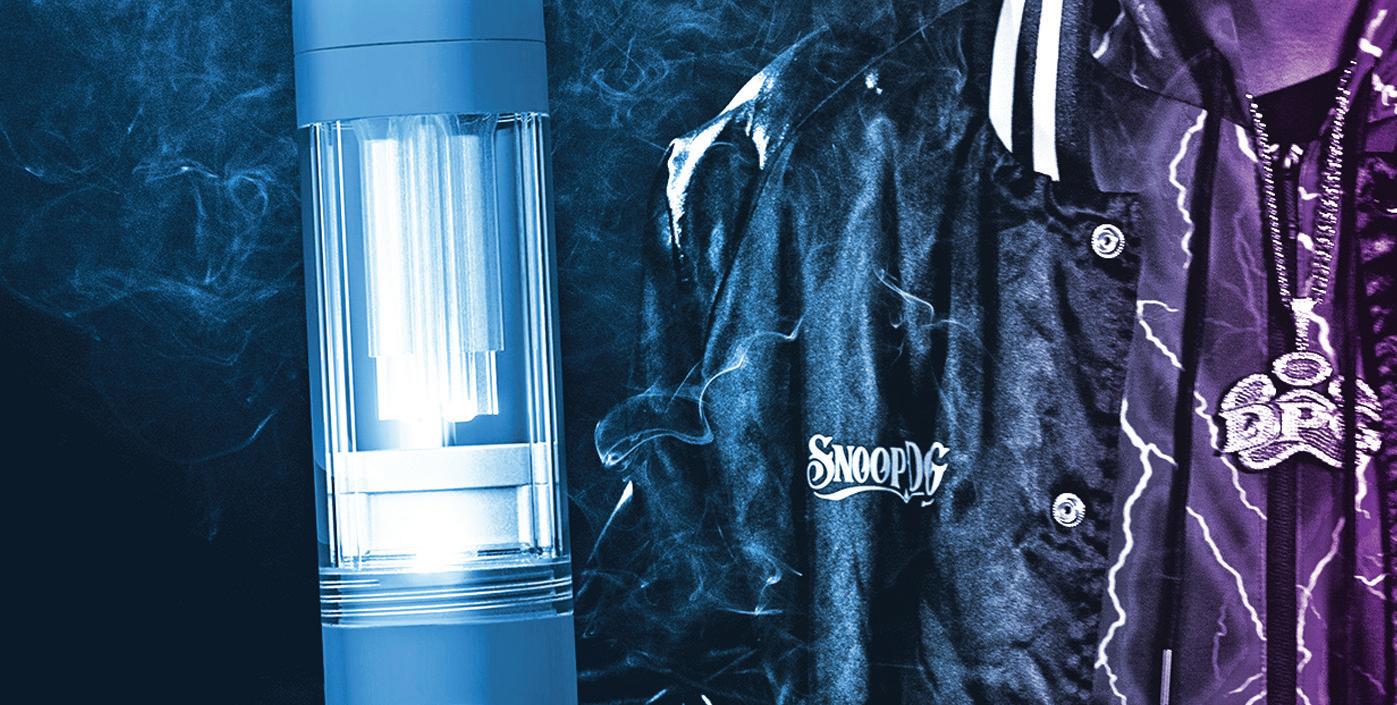
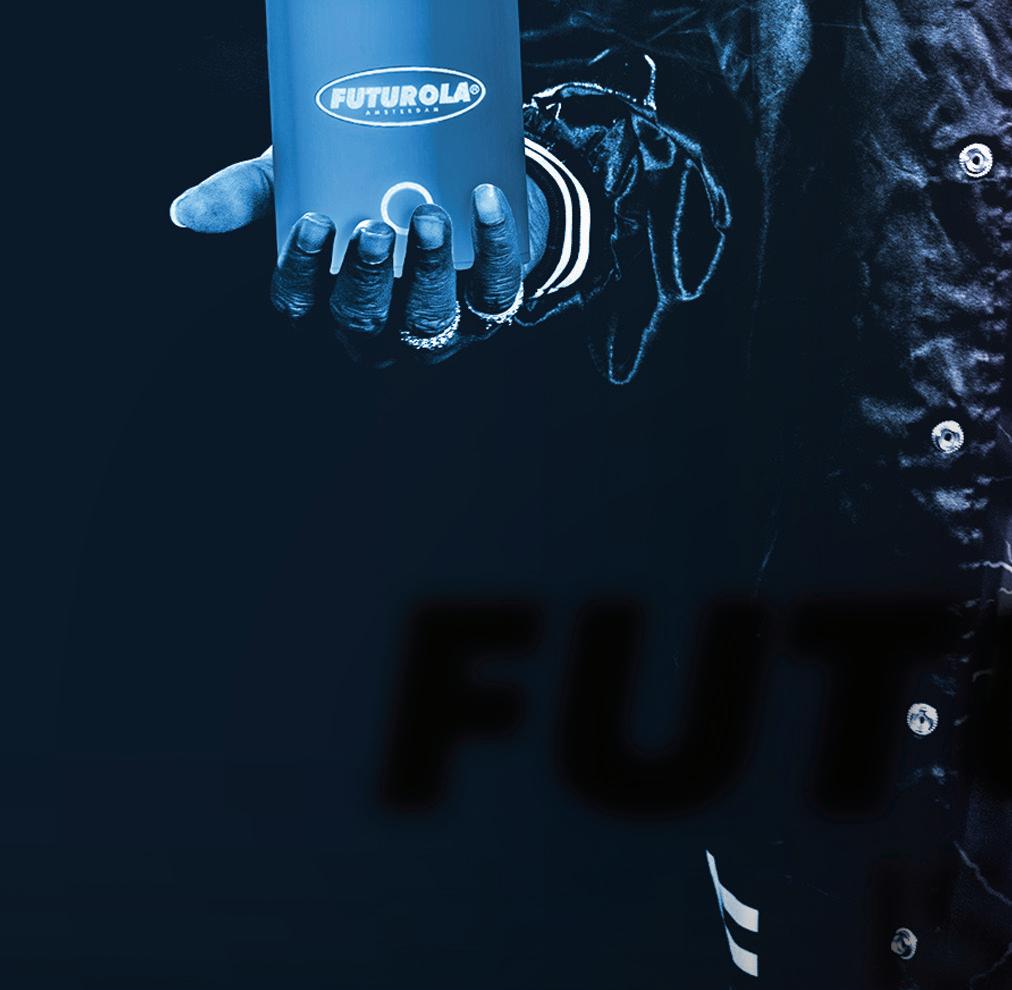

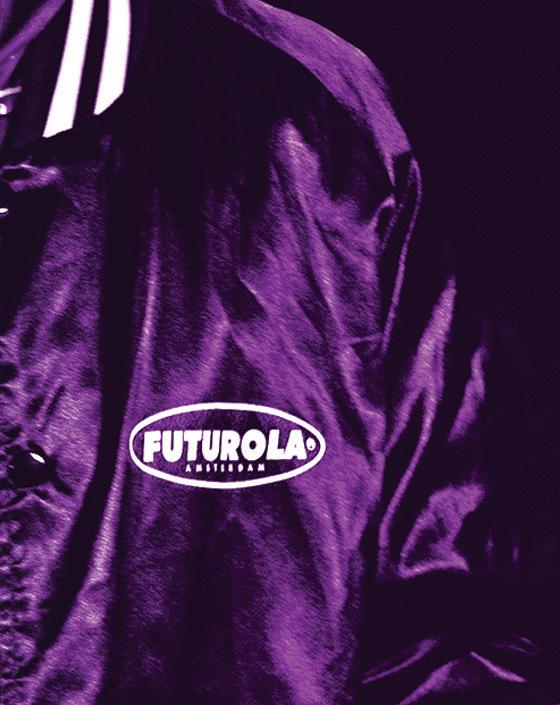
















Futurola Partners With Snoop Dogg to Electrify the Consumer Market


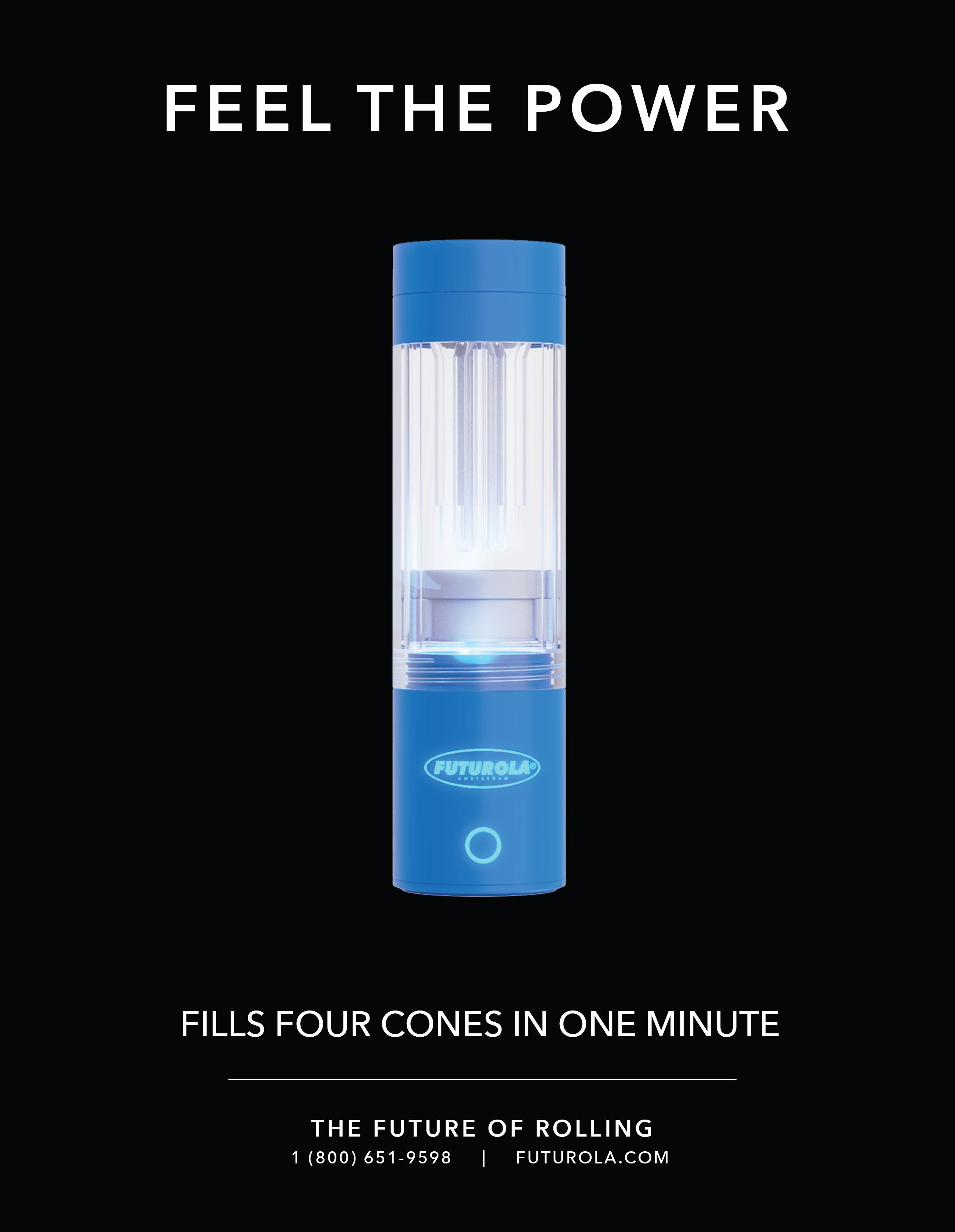







Elevating Cannabis Cultivation Globally Through Education And Best In Class Products






26 Years of Cannabis Research Pioneers of 57 Industry Firsts Behind More Cup Wins Than Any Other Brand
Global Network of Growers in 120+Countries
...And the only line to take cannabis anywhere near the peak of its known genetic potential.


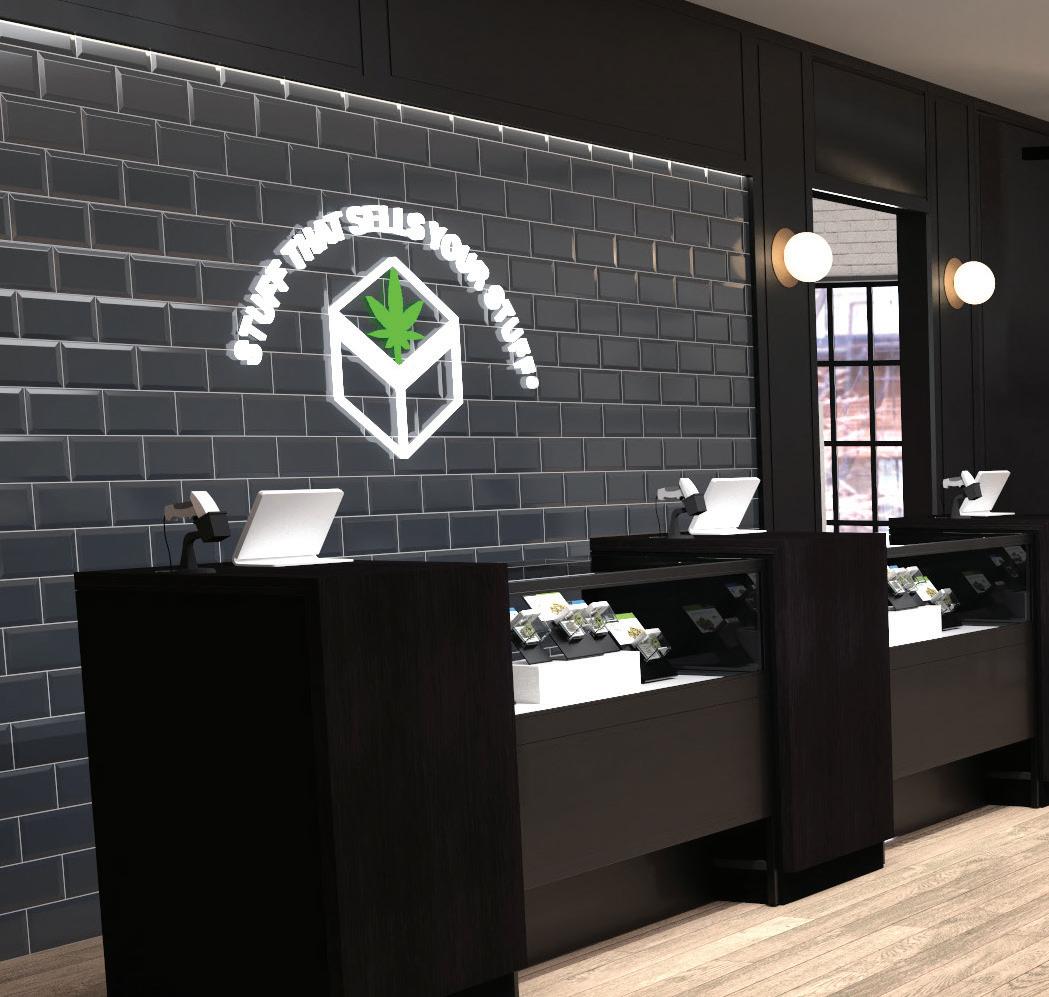







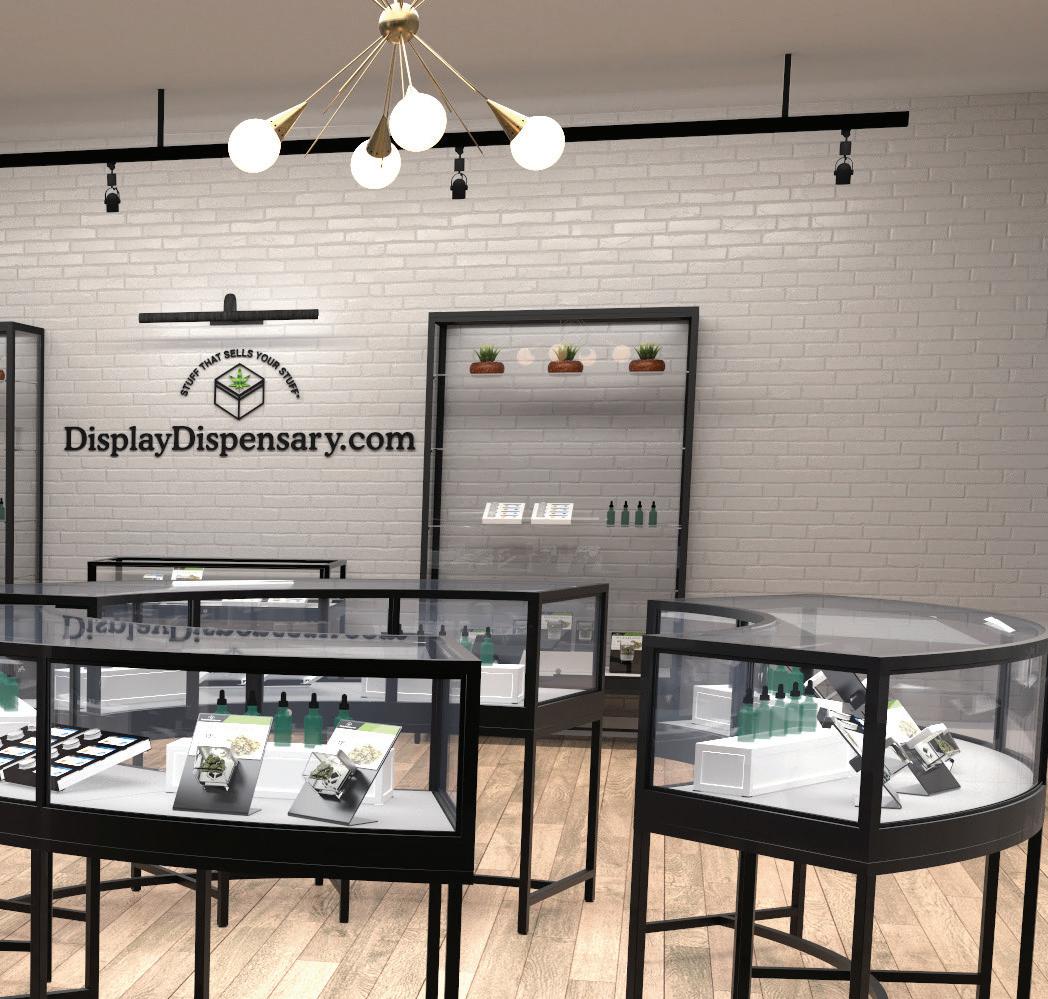




At the forefront of a brave new frontier, advanced technologies like AI-powered shopping assistants, holograms, and connected TV are fueling the rise of “smart stores,” offering retailers new ways to connect with consumers and generate trackable sales.
News, data, trends, forecasts, and other essential information for the wellinformed professional.
Employee benefits are evolving along with the industry. Here’s one way to stay in step.
Twenty-five years after it opened, Berkeley Patients Group remains committed to compassion.
As one dispensary chain learned, a finetuned loyalty program can create many happy returns.
At Dazed Consumption Lounge, what happens in Vegas leaves an enduring impression.
36
Vaporizers are gaining ground on flower. These eight brand-new models demonstrate why.
As prohibition gradually fades, scientists finally are able to give the plant the attention it deserves.
What’s next for banking? We have insight from within the financial services realm.
Alternative dispute resolution can help adversaries collaborate instead of battling in court.
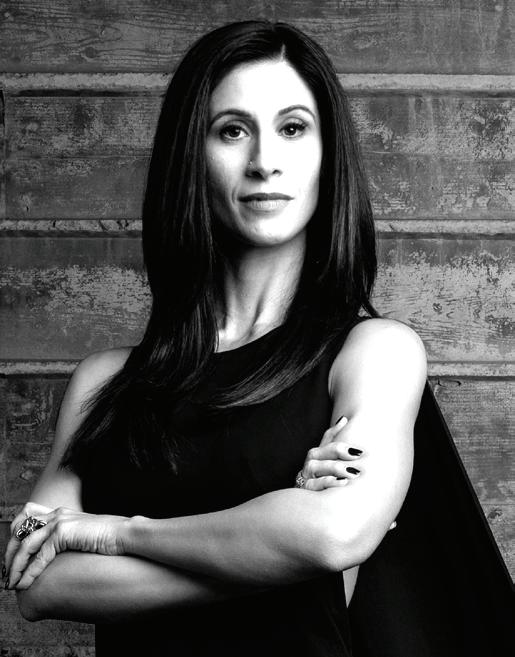
LAURA A. BIANCHI, ESQ.
Bianchi & Brandt Founding Partner
Laura Bianchi began focusing on cannabis law in 2010 and now represents individuals as well as private and public companies in all facets of industry endeavors from applications and start up through operations to continued growth, expansion, and exit.
BianchiBrandt.com
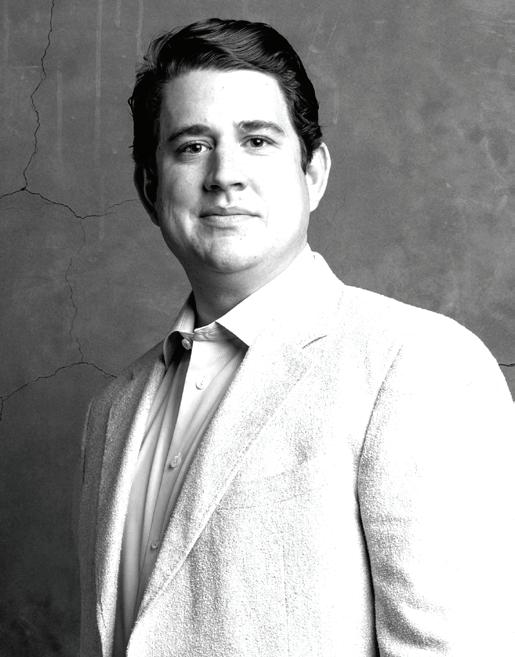
JUSTIN M. BRANDT, ESQ.
For almost a decade, Bianchi & Brandt Founding Partner Justin Brandt has represented cannabis clients including multistate operators, dispensaries, cultivators, and processing operators. In addition, he is a policy expert in the emerging, highly regulated psychedelics arena and a frequent speaker at industry events. BianchiBrandt.com
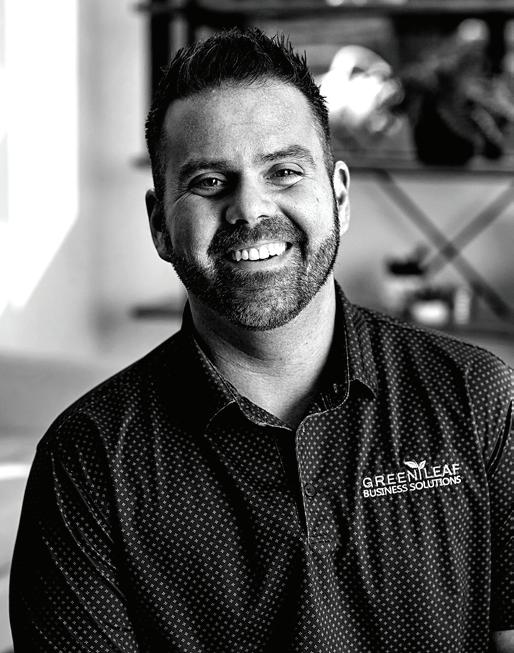
TYLER PRIEST
As chief revenue officer for Green Leaf Payroll and Business Solutions, Tyler Priest boasts a diverse background including roles at Thomson Reuters and Paychex. He is a popular speaker at industry events, helping audiences understand the complex relationships between human capital, payroll, and retirement planning. GreenLeafBizSolutions.com

BRENDAN MCKEE
An avid consumer and advocate of cannabis for more than twenty years, Brendan McKee is co-founder, chief financial officer, and chief operating officer at Silver Therapeutics, which operates dispensaries in Maine, Massachusetts, and Vermont. He entered the legal market with a vertical medical license in 2017 and transitioned to adult-use sales in 2019. Silver-Therapeutics.com
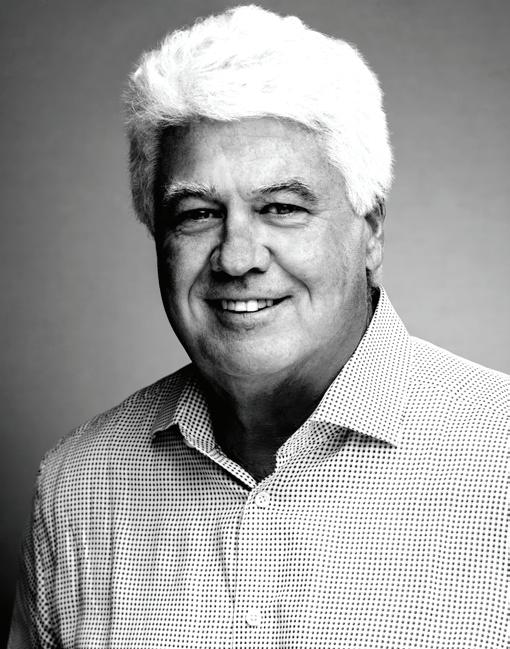
KEVIN HART
After decades leading venture-backed companies, Kevin Hart founded Green Check to connect the cannabis and banking industries using technology that removes barriers and fuels business growth. Previously, he held C-suite positions in the software industry, where he led two companies to acquisition by publicly traded entities and a third to an initial public offering. GreenCheckVerified.com
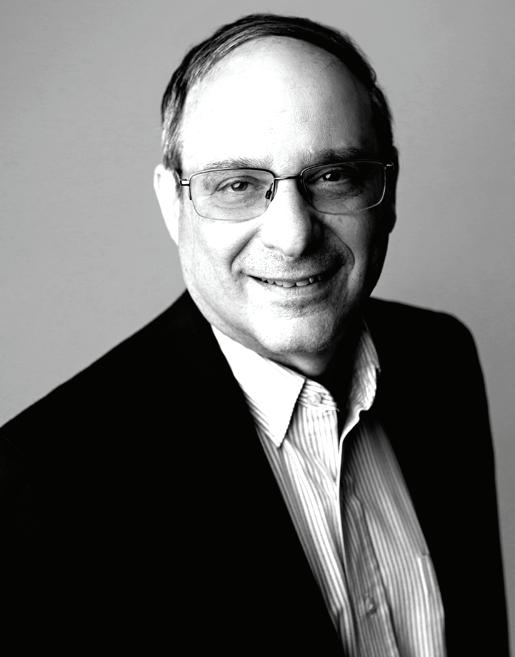
DAVID SANDELMAN
With a lifelong passion for science, David Sandelman invented and patented Vaportrol® Technology, a system that regulates vapor pressure during post-harvest processing to ensure terpene preservation and maintain potency, yield, and quality. He co-founded and serves as chief technology officer at Cannatrol, a drying, curing, and post-harvest storage system. Cannatrols.com
Change is inevitable, but whiplash shouldn’t be. Nevertheless, recent reversals in technology policies have left many folks with a nearly physical pain in the neck.
To be fair, every new administration modifies the relationship between government and industry, but several rapid about-faces in the tech sector during the period immediately preceding and following the presidential inauguration were both shocking and unsettling. TikTok’s brief disappearance from the web in the United States generated significant outrage, not just because it suddenly vanished but also because of the mechanism by which it returned. The naked opportunism of tech bros including Mark Zuckerberg, Sam Altman, and Jeff Bezos—all of whom seem to have abandoned any traces of youthful idealism—left individuals and businesses who engage with social media, artificial intelligence, and cloud services feeling more than a little off-balance. Changes at Facebook and other Meta divisions, combined with new executive orders “strengthening free speech” and rescinding security-related restrictions on AI, left some people feeling less safe, both online and in the real world.
What happened to the Utopian notion technology would deliver global understanding and make humans’ lives easier? Science fiction misled us.
On the other hand, some commercial applications of emerging technologies are tracking in a positive direction—toward useful, fun, and potentially very profitable.
Pam Chmiel takes a look at retail-tech innovations in this issue. Spoiler: Star Trek’s holodeck may be just around the corner.
Also in this issue, we examine how to retain both employees and customers.
According to Brendan McKee, loyalty programs are no longer optional, but they’re easier to implement than ever. And in Tyler Priest’s estimation, retirement programs are essential for the industry’s growth.
One of the inherent ironies of technology is that any given innovation can be simultaneously friend and foe. We can’t stop progress or change or man’s unending quest to reach the horizon … but it’s up to each of us to remember there’s a human cost to every new development. Let’s make good decisions.
Kathee Brewer Editorial Director




Editorial Director Kathee Brewer editorial@inc-media.com
Creative Director Angela Derasmo
Digital Editor Jeff Hale
Digital Strategist Dexter Nelson
Circulation Manager Faith Roberts
Contributing Writers Alyson Jaen Esq., Anthony Coniglio, Brendan McKee, Christopher Jones, Danny Reed, Dan Serard, Darren Gleeman, David Sandelman, Gary Allen, Howard Sykes, Justin M. Brandt Esq., Kevin Hart, Kim Prince, Kris Krane, Lance C. Lambert, Laura A. Bianchi Esq., Marc Beginin Esq., Michael Mejer, Mitchel Chargo Esq., Munzer Sukhun, Rachel Gillette Esq., Rachel Goldman, Ricardo Baca, Richard Proud, Robert T. Hoban Esq., Ruth Rauls Esq., Ryan Hurley Esq., Scott Johnson Esq., Scott Thomas, Shane Johnson MD, Shawna Seldon McGregor, Stacy Litke, Sue Dehnam, Sundie Seefried, Taylor Engle, Tyler Priest
Artists/Photographers Mike Rosati, Christine Bishop
ADVERTISING SALES & CLIENT SERVICES
BRANDI MESTA
Senior Account Executive
Brandi@inc-media.com (424) 703-3198
BUSINESS OFFICES
Chief Executive Darren Roberts
Tech Architect Travis Abeyta
Accounting Diane Sarmiento, Brittany Gambrell
Subscriptions subscribe.mgmagazine.com
Back Issues
store.mgmagazine.com
Mailing Address
mg Magazine
23055 Sherman Way, Box 5069 West Hills, CA 91308 (310) 421-1860 hello@inc-media.com
MEG CASHEL
Account Manager
Meg@inc-media.com (424) 246-8912
mg Magazine: For The Cannabis Professional Vol.11, No.2 (ISSN 2379-1659) is published monthly by Incunabulum LLC, located at 23055 Sherman Way, No. 5069, West Hills CA 91308. Periodicals Postage Paid at Las Vegas Post O ce and additional mailing locations. POSTMASTER: Send all UAA to CFS. NON-POSTAL AND MILITARY FACILITIES: Send address corrections to mg Magazine, 23055 Sherman Way, No. 5069, West Hills CA 91308.
mg is printed in the USA and all rights are reserved. © 2025 by Incunabulum LLC. mg considers its sources reliable and verifies as much data as possible, although reporting inaccuracies can occur; consequently, readers using this information do so at their own risk. Each business opportunity and/or investment inherently contains criteria understanding that the publisher is not rendering legal or financial advice. Neither Incunabulum LLC nor its employees accept any responsibility whatsoever for contributors’ activities or content provided. All letters sent to mg Magazine will be treated as unconditionally assigned for publication, copyright purposes, and use in any publication or brochure and are subject to mg’s unrestricted right to edit and comment.


WASHINGTON – Rescheduling is up in the air again after the administrative law judge assigned to hear arguments for and against the proposal abruptly cancelled a hearing scheduled for January 21 and indicated the process may need to back up a step or two before it can move forward.
At issue are allegations of bias leveled against the Drug Enforcement Administration (DEA), whose role in the proceedings was to have been defending its own proposal that cannabis be moved from Schedule I to the much-less-restrictive Schedule III under the Controlled Substances Act. But, according to Village Farms International Inc. and nonprofit advocacy group Hemp for Victory, DEA’s “improper ex parte communication” with rescheduling opponents including the Tennessee Bureau of Investigation and Smart Approaches to Marijuana, along with DEA Administrator Anne Milgram’s decision to exclude the State of Colorado from the list of designated participants, should disqualify the agency and remove it from the process.
In a ruling issued January 13, DEA Chief Administrative Law Judge John Mulrooney II stated he lacks the authority to disqualify the agency but gave the complainants leave to file an interlocutory petition requesting the incoming
administrator reconsider Milgram’s designated participants list. That could put a significant wrinkle in the rescheduling schedule: The day after his inauguration, President Donald J. Trump tapped retired DEA special agent and “narco-terrorism” expert Derek Maltz, an outspoken skeptic of rescheduling, to serve as interim DEA administrator. Maltz faces no deadline for deciding when or whether to consider the petition. So, “the matter is on stay here, and the administrator will issue a briefing schedule, entertain oral argument if he desires, and issue a binding, written decision” governing how to proceed, Mulrooney wrote in his decision.
Cabinet-level personnel changes also may affect the process. Although Health and Human Services Secretary nominee Robert F. Kennedy Jr. has voiced support for legalizing cannabis and some psychedelics, Attorney General nominee Pam Bondi has been a vocal opponent of legalization since her stint as Florida Attorney General (2011–2019). As head of the Department of Justice, which includes the DEA, the attorney general will have a say in the rescheduling decision.
This is the second time Mulrooney has delayed rescheduling’s progress. During the initial hearing on December 2—which already was later than the industry hoped hearings would start—he requested more documentation from the twenty-five designated participants. Mulrooney set two dates for delivery of those materials, left a little time to mull whether all designated participants were, in fact, qualified, and settled on January 21 as the date he would begin hearing testimony.



SAN FRANCISCO – In January, mainstream delivery service DoorDash began delivering intoxicating hempderived THC products in select states. Adults may order edibles, beverages, and topicals from merchants including Total Wine & More, ABC Fine Wine & Spirits, and the company’s in-house fulfillment platform, DashMart.
Consumers in relevant markets will find a product menu behind a special CBD/THC tab in the DoorDash app. As with beer, wine, and spirits, which Dashers have delivered since 2021, the company requires electronic identity verification when an order is placed and an in-person ID check upon delivery. Brands vary by location, but Cann, CBD Living, Green Herbal Care, and
Powered by
Smoking Dog are among the national names on the menu in Texas, where the Compassionate Use Act allows only registered patients with one of nine debilitating conditions to access limited types of low-THC medical cannabis, primarily as oil. In more progressive markets, consumers undoubtedly will find a broader range of brands and product formats, as large multistate operators including Green Thumb Industries, Curaleaf, Wana Brands, Kiva, Wyld, and Tilray have launched hemp lines in the United States within the past year.
Hemp-derived THC is presumed federally legal under the 2018 Farm Bill, but fifteen states either heavily restrict or have outlawed products containing intoxicating hemp-derived cannabinoids
like delta-9 THC, delta-8 THC, and THCA. In addition, intoxicating hemp could be on the federal chopping block later this year when Congress reconsiders the Farm Bill’s next iteration. Both House and Senate versions of a bill marked up in 2024 attempted to redefine legal hemp as comprising only naturally occurring, non-intoxicating cannabinoids.
DoorDash’s foray into what may be a short-lived market comes as a growing number of people seek alternatives to alcohol for relaxation or social lubrication. Nearly 75 percent of adult respondents to a recent Harris Poll said they have considered incorporating THC or CBD into their routine; an equal percentage indicated they considered participating in Dry January this year.
Customer retention is crucial for cannabis retailers in 2025.
Retaining loyal customers is much more cost-e ective than acquiring new ones, with repeat customers spending up to 67% more than rst-time buyers.
Dispensaries implementing a strong omnichannel strategy have seen retention rates as high as 89%. Owning the data from your sales channels is essential to driving consumer behavior.
Recommendation:
Consider investing in native e-commerce channels that provide a consistent experience in-store and online. i.e. kiosk, website menu, and mobile app.

LOS ANGELES – The founder and chairman of Hightimes Holding Corp. could face a statutory maximum of five years in federal prison after pleading guilty in January to participating in a criminal conspiracy to inflate sales of the company’s stock.
In December, federal authorities charged Adam Levin, 45, of Marina Del Rey, California, with one felony count of conspiracy to tout securities for undisclosed compensation. According to his plea, Levin admitted paying more than $150,000 to Jonathan William Mikula, a securities analyst and publisher of the “Palm Beach Venture” newsletter. Levin additionally participated in providing Mikula with “tens of thousands of dollars” in entertainment. To conceal the scheme, Levin and his associates entered into a sham marketing agreement and routed the payments through a Canadian bank to a shell company in Canada.
In return for the money and other perks, Mikula promoted Hightimes stock to the newsletter’s nationwide audience while telling readers he had no financial relationship with Levin or Hightimes. Federal law requires full and public disclosure from anyone who receives payment—directly or indirectly—for publishing, publicizing, or circulating any advertisement or communication that describes a security offered for sale.
Levin also admitted he lied to the United States Securities and Exchange Commission (SEC) when he told investigators
his associates concocted and deployed the pay-for-play scheme without his knowledge.
Prosecutors said the under-the-table deal helped Hightimes raise at least $6 million from stock sales.
Levin was charged alongside Mikula; Christian Fernandez, who authorities said acted as a money launderer for the scheme; and Amit Raj Beri, a Beverly Hills businessman who brokered deals for undisclosed payments. Mikula, Fernandez, and Beri each pleaded guilty last year and are scheduled to be sentenced in July.
Hightimes, which saw its assets sold off piecemeal earlier this year after the company entered receivership, was the parent company of High Times and other magazines, several websites and trade shows, and a now-closed chain of High Times dispensaries. The magazine’s website, which has not been updated since June 2024, now is registered to an intellectual property law firm in Washington, DC.
The current case is not the first time Hightimes and Levin have run afoul of U.S. securities laws. In September 2023, the two paid the SEC more than $660,000 to settle charges of “fraudulent conduct in the offer or sale of securities” after they continued to promote the company’s stock as a Regulation A offering even though the registration had been revoked.
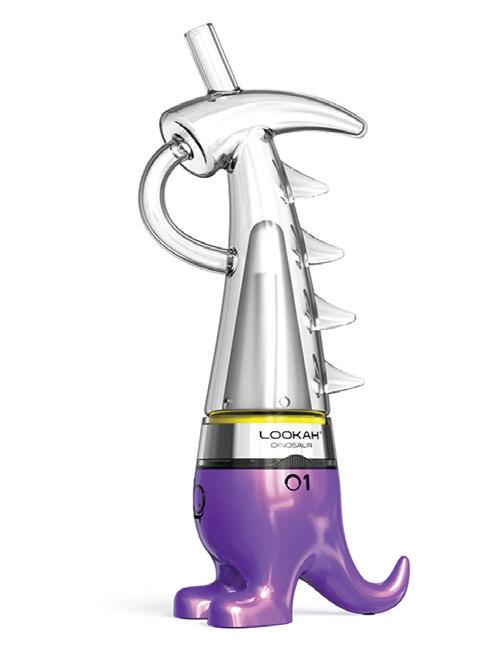
Concentrates and the consumers who enjoy them are evolving—and so is the hardware they use. Designed to make dabbing more efficient and customizable, Lookah’s Dinosaur rig dispenses with the traditional torch-and-nail setup in favor of more precise temperature control. The unit heats to a user-set temperature in seconds, allowing a better flavor and potency experience. Compact, lightweight, and portable, the Dinosaur’s whimsical glass bubbler with a spiked back and bent “head” prevent splashback, and a digital display tracks the charge remaining in the 950mAh battery hidden in the base. lookah.com

The toothless design of Flower Mill USA’s grinders uses twenty food-grade, stainless-steel flutes to grab and roll plant material, breaking it apart naturally. Compact, three-piece construction makes the device easy to clean, and a deep milling chamber provides extra capacity for storing ground flower. Available in five colors and two sizes, the grinders are constructed of BPA-free plastic and aluminum and incorporate a removable stainless-steel pollen screen. flowermillusa.com





























For the consumer experience, dose matters as much as the product you sell them.
or exp x erience, you fi
Help your customers find their “just right” by educating them on mindful dosing.* Because when they learn their perfect dose - their experience, and your service, truly stands out.
*where permitted by law
nd educating mindfu f l dosing.* wh w en they their perfe f ct dose their exp x erience, and your serv r ice, truly out. here
5%
with whom:
5%


Jointly’s insights are calculated from millions of consumption data points & product ratings from real consumers in the Jointly app, who shop, rate products, & track their experiences to reach their goals with cannabis
(Source: New Frontier Data)




As the jobs market becomes more competitive, companies that offer robust benefits will avoid the hidden costs of employee turnover.
BY TYLER PRIEST
Despite an increase in market growth, the cannabis industry continues to grapple with a stagnant job market. Over the past three years, according to Green Leaf Business Solutions’ 2024 Cannabis Compensation Survey Summary Report, base pay rates have fallen short of traditional industries’ typical annual increases of 3–8 percent.
That may be one reason the industry suffers from a high turnover rate. Staffing firm Vangst found a staggering 55-percent turnover rate for budtenders in particular. Green Leaf’s survey summary report discovered turnover and talent loss can cost employers double the salary of the departing employee.
In 2025, retention strategies will be more critical than ever. The question is, what’s the best retention strategy? A reliable 401(k) retirement option can help. Historically (and currently), cannabis operators have had to deal with federal restrictions and compliance complexities that prevent many of them from offering retirement plans to their employees. Since the plant remains federally illegal, most financial institutions hesitate to work with cannabis-related businesses (CRBs). That’s largely because financial institutions fear violating the Bank Secrecy Act, a set of laws passed by Congress in 1970 to help fight money laundering in the United States.
What does that have to do with cannabis businesses?
Taking money from workers in a federally illegal business and investing it in mutual funds or stocks could be considered money laundering.
This lack of access to a retirement solution not only hinders workforce retention but also impacts the long-term financial security of employees. Employees must consider the pros and cons of working in cannabis versus a traditional industry that can offer them a surefire retirement plan. Over time, attrition will outpace hiring, leaving the industry without enough key personnel to sustain normal business.
A 401(k) solution could be a primary catalyst for companies’ growth and a healthier industry. But with all the legal and financial hurdles operators face, how can they find (and afford) retirement plans that could help foster retention?
There are more options than you may think.
• Pooled employer plans (PEPs) are fully vetted and transparent 401(k) plans designed for licensed companies. The PEP 401(k) model provides simplicity, reduced risk, and potential cost savings for operators.
• Multiple-employer 401(k) plans (MEPs) are an alternative to traditional 401(k) options. These plans require a MEP sponsor who is generally a third-party service provider like a payroll company or benefits broker. The MEP sponsor takes a fiduciary role in the plan and decides whether employers may join.
• State-run retirement savings programs allow companies to comply with local mandates requiring employers to provide retirement programs. Examples include California’s CalSavers and OregonSaves.
Great! So there are legal and effective ways for CRBs to offer 401(k) programs. But how can my business benefit from offering a plan?
For starters, providing a sufficient 401(k) program is vital to improving employee retention. According to the Pew Research Center, 43 percent of workers in any field who quit their jobs do so because of inadequate benefits. Providing a quality retirement plan gives
employees an increased sense of financial security which, in turn, increases job satisfaction and loyalty. In fact, research from people-management platform Gusto found employees with an active 401(k) are 32 percent less likely to leave their job. Even more impressive, Gusto discovered offering a retirement plan can save small and medium-sized businesses as much as $100,000 annually in employee turnover costs.
Also consider the cannabis industry is becoming more saturated every year. One way a business can stand out and attract top-tier talent in a competitive job market is to offer employees a robust benefits package including a 401(k) program.


A 401(k) option could be a primary catalyst for company growth.
In addition, providing 401(k) options increases the legitimacy of the industry as a whole. According to financial news outlet Benzinga, “Every 401(k) plan offered in the cannabis industry is a step toward normalizing and legitimizing the cannabis workforce, giving employees access to benefits typically associated with more established industries.”
By investing in their workforce today, licensed operators can ensure a thriving, more professionalized industry tomorrow—one where employees aren’t just part of the movement but are set up to grow and thrive alongside it. The time to take action on providing better benefits for employees is now.
Berkeley Patients Group, the oldest continuously operating dispensary in the United States, remains committed to its original missions: advocacy and helping patients find relief.
BY TAYLOR ENGLE
Since 1999, Berkeley Patients Group (BPG) has been a bulwark of the California cannabis community and a key stakeholder in the industry’s evolution. As one of the oldest dispensaries in the United States, BPG has earned a strong reputation for providing access in a compassionate, patient-focused manner—an art that sometimes is overlooked as the industry pushes ahead with adult-use legalization. But with roots deeply planted during the first wave of the medical-cannabis movement, BPG has remained committed to medical-grade quality and service even while expanding its selection of products to meet the needs of an evolving consumer base.
From the beginning, the pioneering dispensary invested in not only building a community around compassion and care but also advocacy.
“We were the second generation of dispensaries in California, the first being Dennis Peron,” said Vice President Etienne Fontan. [Peron founded the San Francisco Cannabis Buyers Club, the first public cannabis dispensary in California, in 1991. —Ed.] “Our founder, Jim McClellan, decided to open up shop because he was an AIDS patient; he knew the needs of the community and felt the need to be there for them. That happened to be in the way of providing medical cannabis and other free ancillary services like acupuncture, massage, and on-site consumption.”
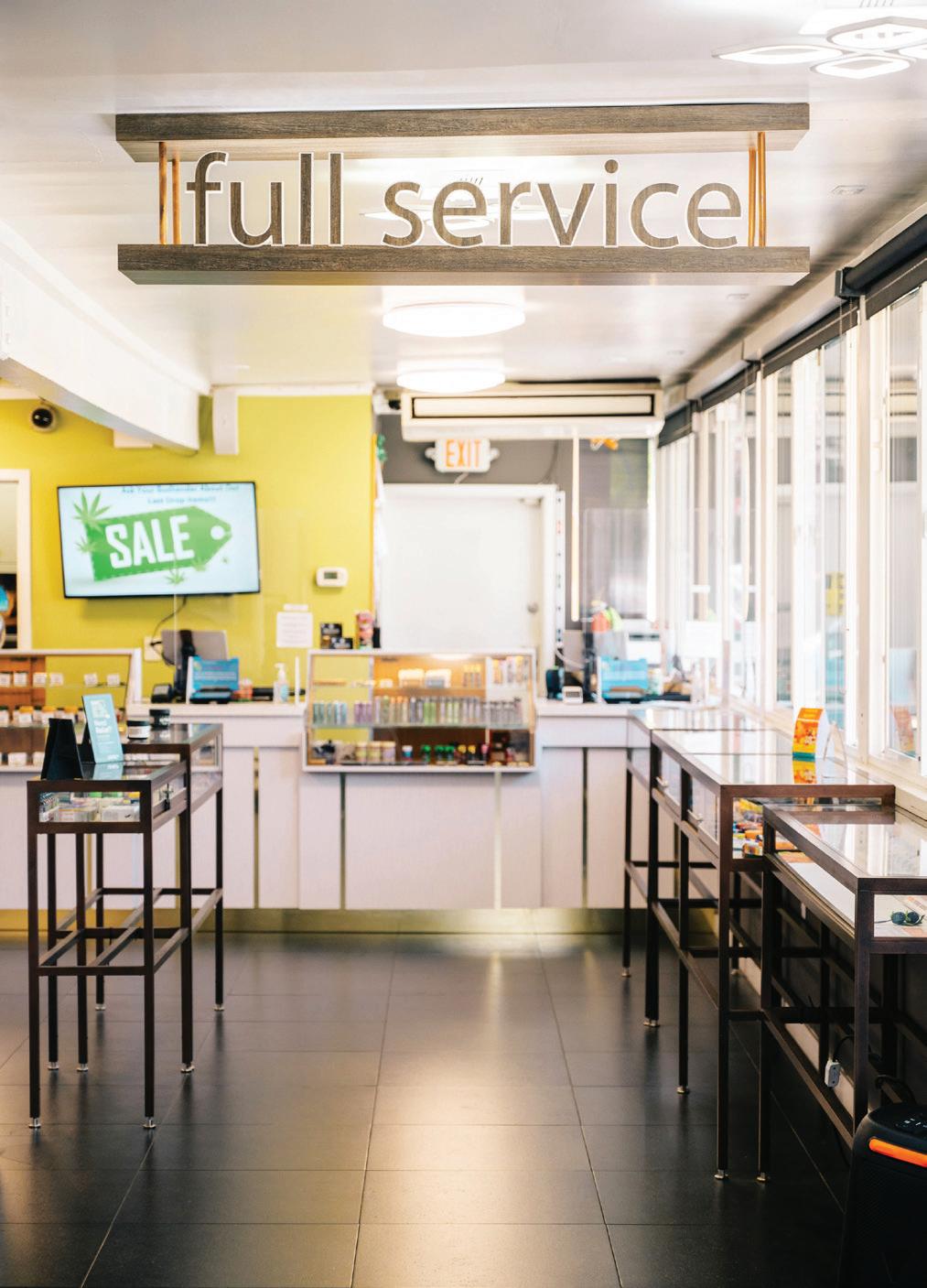
Fontan refers to the early years as “the dark days,” when—depite California voters legalizing medical use in 1996 with approval of Proposition 215—dealing in plant medicine remained mostly underground and risky. Initially, the law allowed cultivation and personal use with a physician’s recommendation, but the legality of sales was anything but straightforward.
“For the most part, [we were engaging in] outright federal disobedience,” he said. “We were hiring activists only, and we were expecting to be arrested any day and every day. That was the reality we faced. And against our lawyer’s wishes, we documented everything. We always felt we were going to have to fight this in court, and back then, there was no federal defense for medical cannabis.”
In the early 2000s, BPG played a critical role in the medical movement, pushing for changes to the legal framework. The dispensary’s staff was instrumental in educating the public and lawmakers about the plant’s medicinal benefits, working with local organizations to provide resources to patients who needed those benefits most. Such advocacy was key in shaping the dispensary’s reputation for compassion.
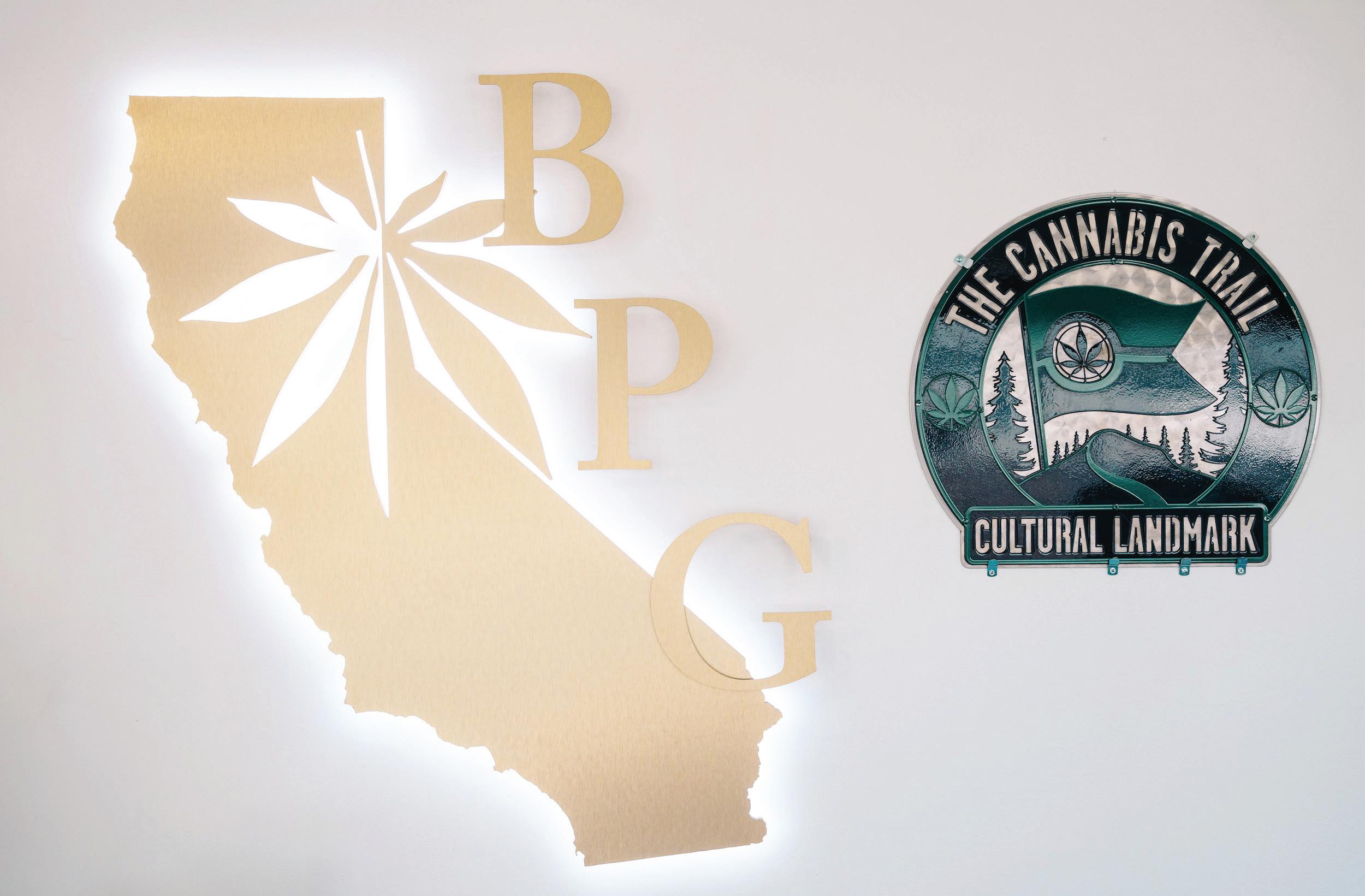
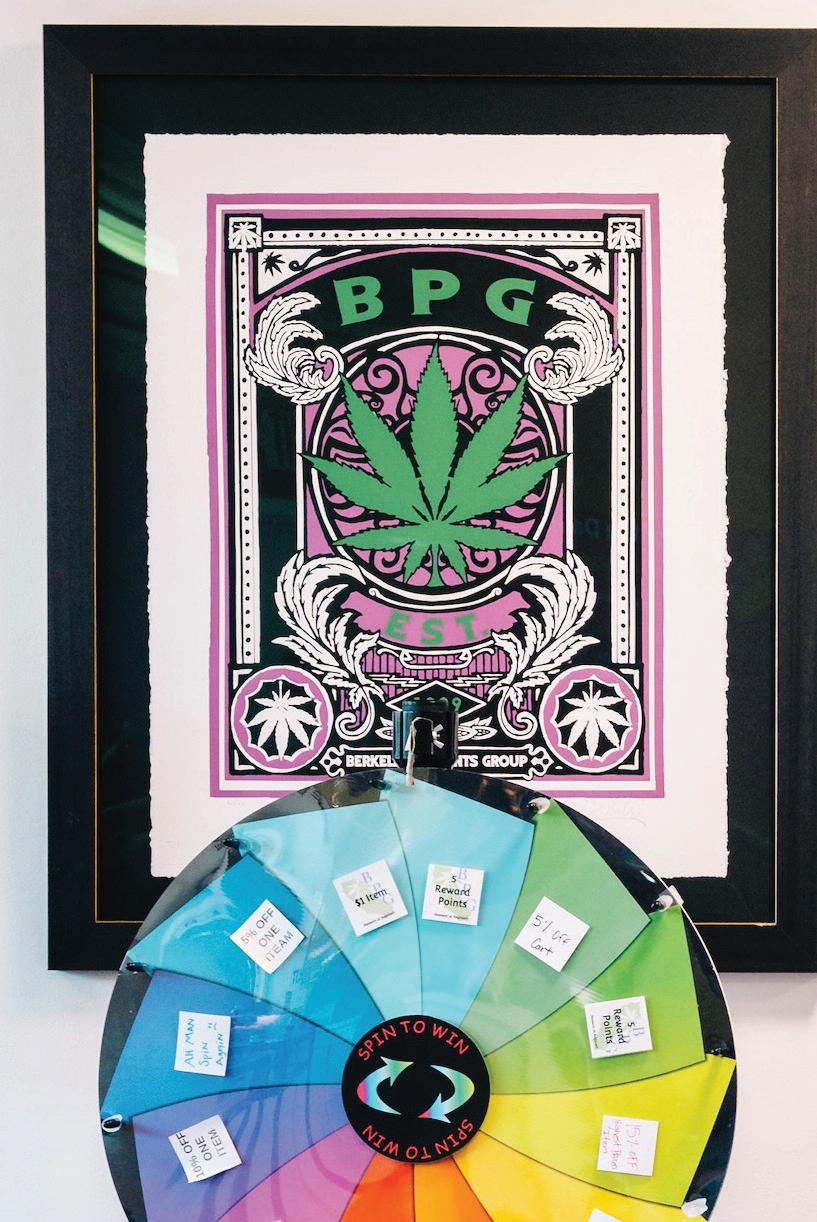
“BPG has always been by patients, for patients,” Fontan said. “I’m a Desert Storm combat veteran and a pre-[Prop] 215 patient on top of that. I learned early on that my medicine was illegal, and I got tired of making criminals out of my friends just to have access. So, our team decided to use our white privilege to push the issue, not only in our actions, but to fund activism around us. Americans for Safe Access came out of BPG; so did the National Cannabis Industry Association and others. We’ve always come from an activist background, stalwart in our belief that we’d rather sacrifice ourselves for the future than sit around and rest on laurels.”
Between 2007 and 2012, as the result of letter-writing campaigns and coordinated attacks by federal prosecutors, BPG was evicted from several locations and had its assets seized. In one instance, the dispensary had to move because it was sixteen feet too close to a school (even though the city had approved on-site consumption at the spot). For five months in mid-2012, the group pivoted to a delivery model until finding the location in which the dispensary currently operates. The doors reopened December 19, 2012.
In 2014, the Rohrabacher-Farr amendment halted federal harassment by prohibiting the Department of Justice from using federal funds to interfere with state-legal cannabis programs—but not before the feds initiated a forfeiture
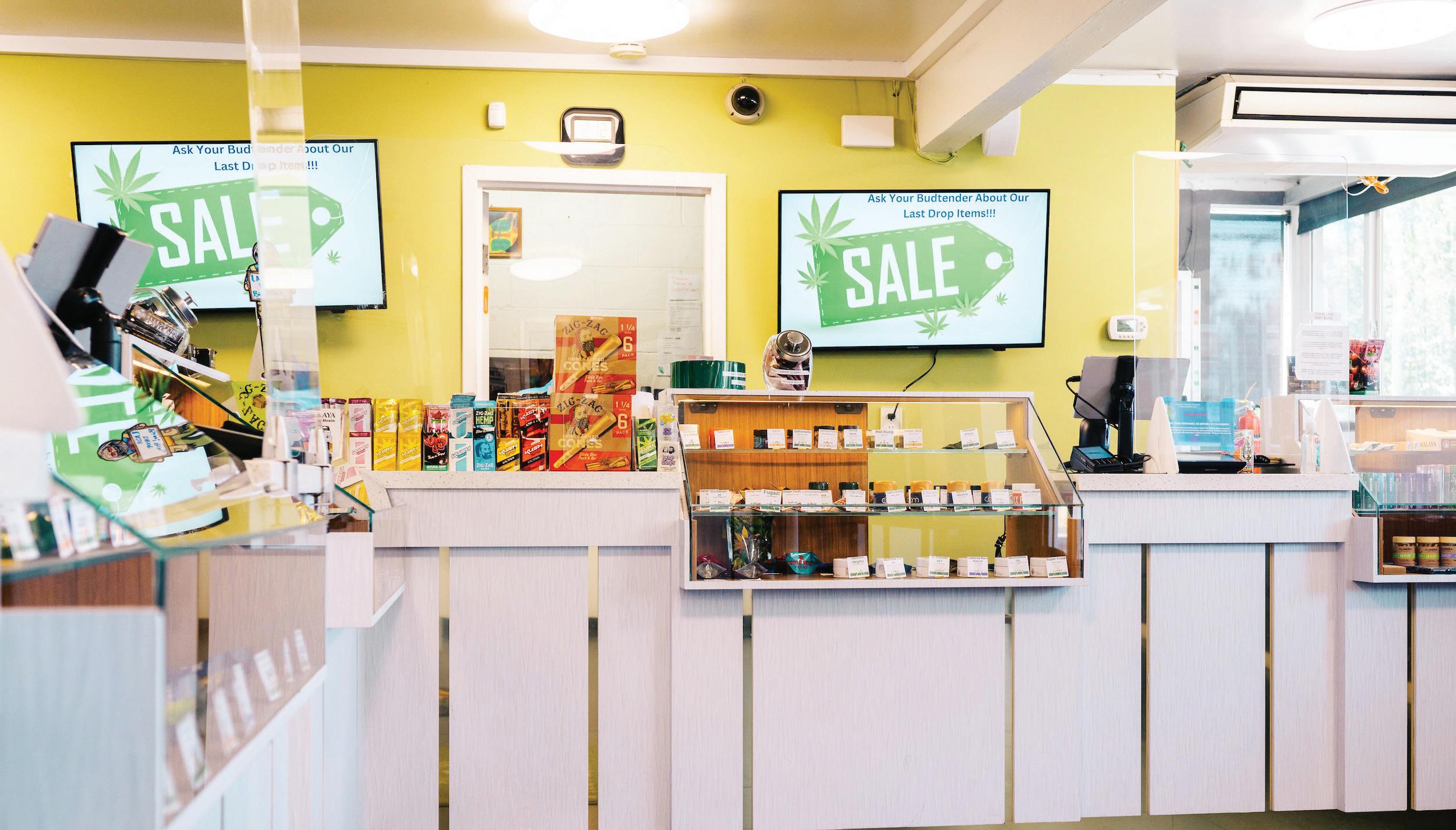
action against the property BPG leased in an attempt to shutter the dispensary and three others in the state. More than three years later, one week before California voters approved adult use at the polls in November 2016, federal prosecutors dismissed the case with prejudice, setting a significant legal precedent.
But challenges continued.
“We got hit with [Internal Revenue Code Section] 280E a year and a day after that,” Fontan said, chuckling. “But we’ve won seven out of seven legal fights over the past twenty-five years. So, when people ask, ‘How was it pioneering cannabis?’ I say, ‘A lot of bumps, bruises, knives, and swords.’ We sustained a lot of cut wounds, but somehow we didn’t bleed out and we’re still standing strong today.
“And when people ask, ‘Did you ever anticipate being here twenty-five years later?’ I say, ‘No, we expected to go to jail,’” he continued. “When I was a post-war activist thirty years ago, people were saying, ‘Hey, kid, give it up.’ But, fortunately, enough of us activists didn’t listen.”
Today, BPG caters to both medical patients and adultuse consumers, offering education, a curated selection of products, and a team of experts ready to guide each visitor through the process. The store’s appearance hasn’t changed much since its reopening in 2012, but part of the dispensary’s charm is in the comfort of familiarity. A
bright, cozy design and cheerful staff keep locals returning for camaraderie along with their cannabis.
“We’re still a compassionate center, but our move into the adult-use sector has resulted in a surprising shift in demographics,” Fontan said. “The amount of older, retired women we started seeing really surprised me. Some of them come in because they’re retired and no longer have to take a piss test, and a lot of them are seeking insomnia relief. But in general, they’ve found a modality and an entry point that is comfortable for them to access.
“The consumer base is generally becoming more widely understanding of these different modalities and needs,” he added. “Just look at the shift in gummies alone. We see them in cannabis, but look at how many other multivitamin and medicine brands are now using gummies because that form is more palatable for people. That started with cannabis.”
Despite the shift, BPG remains committed to the medical community. Just as it always has, the team still finds ways to provide plant medicine to patients who can’t afford it.
“We’re proud to have arrived here,” Fontan said. “The horizon looks bright, even if we’re in a somewhat dim period. We look forward to continuing to work toward federal and international change, and we’re thankful for all the people who helped us get here.”
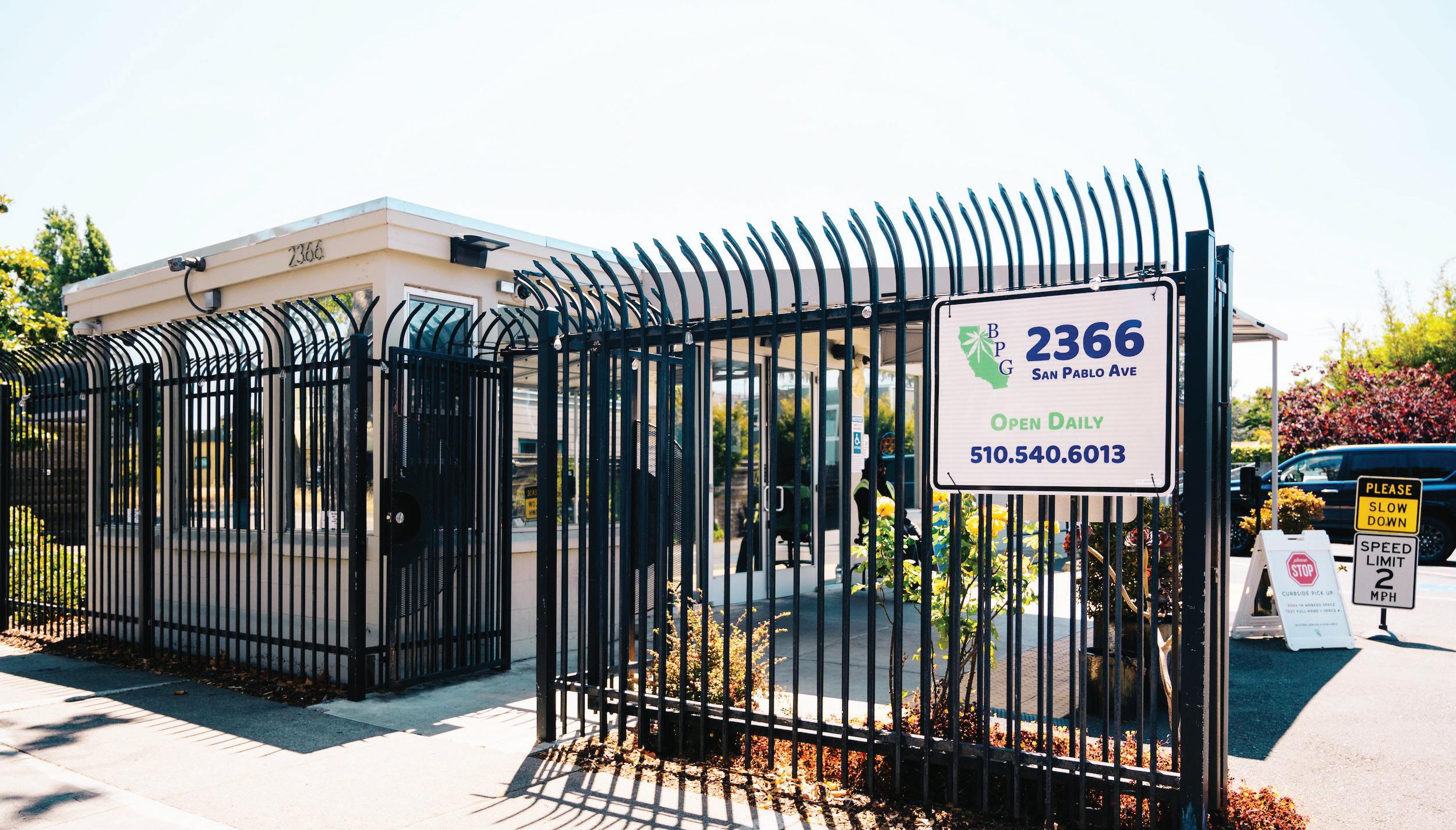
The right rewards can create many happy returns.
BY BRENDAN MCKEE

Historically, customer retention at dispensaries is sub-optimal, making the issue a continuing concern for operators nationwide. A Happy Cabbage study found over a five-year period, only 16 percent of customers at five separate retailers continued to shop at the same dispensary after their first visit. What can retailers do to increase customer retention? The short answer is “implement a loyalty program.” Allow me to explain.
According to e-commerce solutions provider Yotpo, loyalty programs drive 83 percent of consumers to make repeat purchases. I can vouch for that. Since
implementing a loyalty program at our dispensaries in Massachusetts, Maine, Vermont, and New York, I’ve observed an increase in customer retention as well as a noticeable uptick in the frequency of visits. It’s clear the program has been effective in encouraging customers to return more often.
Additionally, loyalty programs are particularly beneficial when launching specific brands or highlighting special offerings. In our industry, brands must be mindful of certain terminology—since words like “specials” and “deals” aren’t permitted in some markets. Developing loyalty programs is a creative
way to communicate these promotions. For example, loyalty program members might gain access to “new pricing,” “price drops,” or “additional savings.”
Even with regulatory limitations, brands can do a great job creating a loyalty program that works within the rules while still offering real value to customers. A great place to start is to borrow ideas from outside industries and adapt them to fit the cannabis space. For example, visit your local Starbucks and ask the team what customers like most about their rewards program and how it fosters loyalty. This allows you to gather insights and see what strategies potentially could translate to our industry.
While there aren’t massive differences in how customers respond to loyalty programs across industries, the regulatory constraints we face mean we must be more creative and cautious in how we structure and present our offerings. Nevertheless, several types of loyalty programs have significant potential to retain loyal customers.
One loyalty program functions like a 5-percent-cashback system. Essentially, customers earn 5 percent of their purchases in credits that can be used for future purchases. For example, if someone spends $100, they earn $5 in credits, which may be applied immediately or saved to accumulate in their loyalty account.
Birthday rewards allow customers to choose a product from a curated selection on their birthday or within a specified time period near that date. The store “pennies out” the price as a gift. This is where email segmentation and drip campaigns are important. Designing personalized emails to acknowledge customer birthdays and encourage a visit during that time is essential for success.
Bonus rewards compose another loyalty strategy that can prove beneficial. For instance, if a customer spends a certain amount, consider giving them a branded hat, beanie, or T-shirt as a token of appreciation. This is a good way to be committed to doing everything you can within regulatory limits to reward your customers and keep them coming back. If you give branded merch, it’s also a subtle-but-effective marketing tactic.
Before launching, thoroughly test your program. Go through proper protocols and pressure-test the program with your team to identify and resolve any issues. Nothing harms a launch more than introducing a program with bugs or glitches. Taking the time
to troubleshoot ensures a smoother experience for customers and avoids damaging their trust.
Be very clear—both internally with your team and externally with your customers and community—about the terms of your loyalty program. Clearly outline what customers stand to earn or get back. Ensure the details of your program are easily accessible: Spell out everything on your website, create a blog post about the terms and benefits, and include links to other relevant pages. Make it abundantly clear, in as many ways as you can, what the program offers, how it works, and how customers can track their rewards.
Don’t forget to gauge the impact of your loyalty program and adjust as necessary. One place to start is by looking at the lifetime spend of your loyal customers and calculating the percentage of your revenue they contribute. On top of that, track how many new customers you bring in each month, regardless of whether they sign up for rewards.
Of course you want as many people as possible to join the loyalty program, but understand that not everyone will be interested. Some customers, particularly those in older age groups, may prefer a straightforward experience. They may just want to visit the store, make their purchase, and leave without dealing with digital programs.
In mature or saturated markets, offering a loyalty program is a no-brainer. It’s essential to listen to your team and your customers to shape a program that aligns with their needs and desires. That said, don’t aim for perfection. It’s better to launch a functional program that delivers core value than to delay indefinitely while trying to ensure the finished product offers everything you envisioned. You can always make adjustments and improvements after the program is live. Avoid analysis paralysis. If your program is clear, functional, and compliant, launch it and refine over time.
A well-executed loyalty program helps you retain customers and stay competitive. If you don’t currently offer one (or haven’t even considered offering one), you risk falling behind. I strongly encourage operators to think about implementing a loyalty program and launching it within the limits of their state or market regulations. Rewarding loyal customers pays dividends in customer retention and long-term growth.
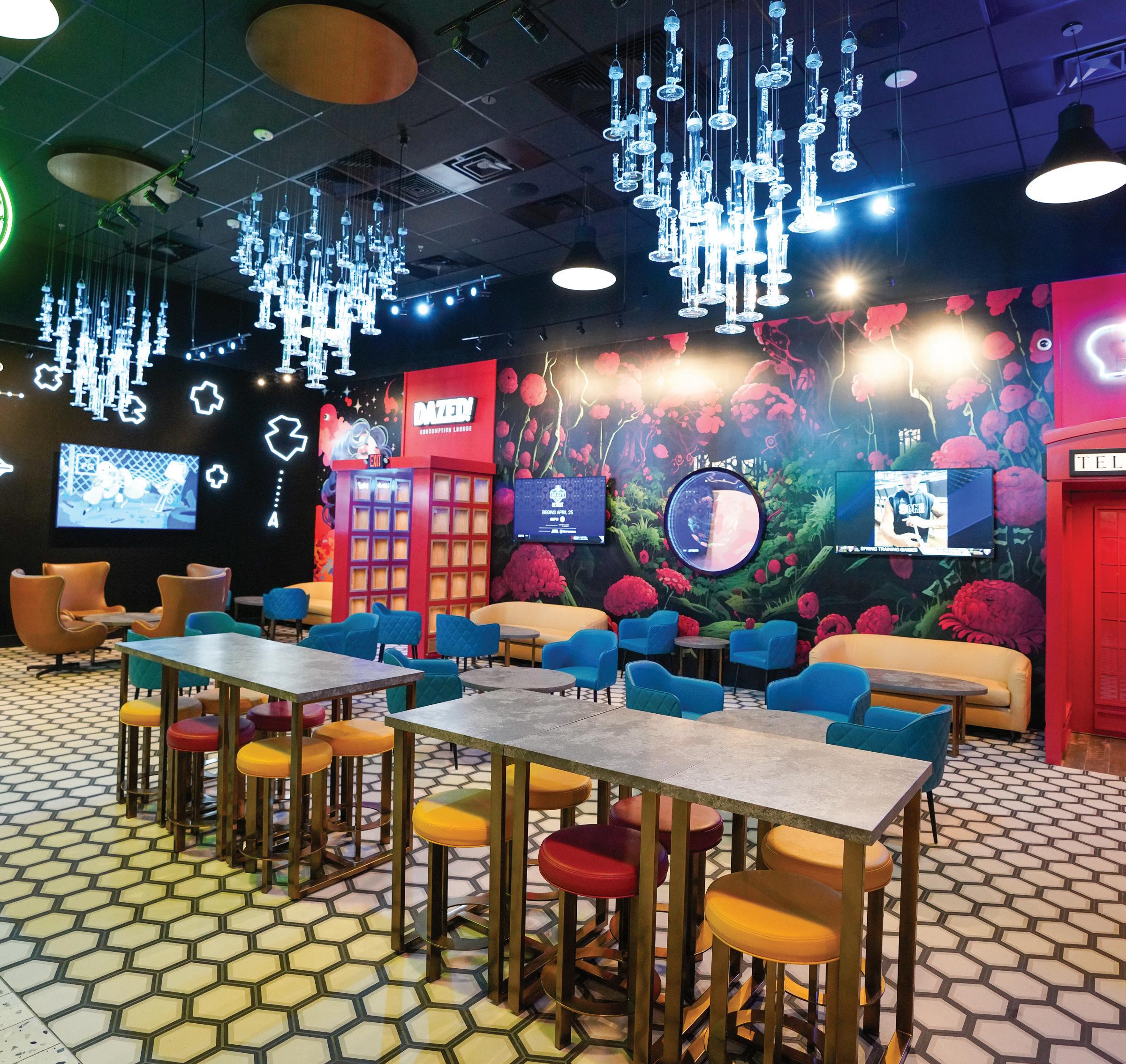
Hewing to the tradition of parent company Planet 13, Las Vegas’s Dazed Consumption Lounge is vivid and interactive.
BY TAYLOR ENGLE
In a city defined by nightlife, excess, and endless entertainment, Dazed Consumption Lounge brings a dazzling slice of cannabis culture to America’s adult playground. The speakeasy-inspired space—the newest in Planet 13’s expanding empire—blends mind-bending aesthetics with thoughtful functionality to create a destination for tourists, locals, connoisseurs, and novice consumers. The journey into the lounge begins with a phone call.
“The entrance is a bit of a secret,” said Vice President of Retail Operations Lowell Brown. “When you approach the front door, you’re actually walking into an old-school, English-style phone booth. We wanted to make the entrance area private because a lot of people have never consumed in public before, and the idea of being watched or seen can be intimidating. We wanted it to be private and comfortable—to really put people at ease before they step inside.”
It's like entering the Willy Wonka chocolate factory. —Lowell Brown, vice president
Those who have never used a rotary phone may be a little lost at first, but a hostess is available to demonstrate the proper technique.
“The hostess will say, ‘Spin the rotary, put in the numbers 420, and push the door open,” Brown said. “From there, visitors embark on an experience I can only describe as like entering the Willy Wonka chocolate factory. All of a sudden, they’re in a wonderland of lights, colors, and aromas.”
From the moment a visitor steps inside, it’s clear every detail has been thoughtfully curated to delight and ignite the senses. The lighting alone is a showstopper. Crafted by renowned glass-blowing company GRAV, glass bong chandeliers adorn the space, bathing the lounge in a kaleidoscope
of hues. A mural depicting a mystical forest of red trees and green hills adds to the immersive, if surreal, experience.
“That first aesthetic of the phone booth really carries throughout the lounge,” Brown said, clearly pleased with the effect. “You find yourself in this mental state where you’re transported into a world of color, creativity, and enjoyment.”
Spaceships adorn some walls, while colorful, Zen-inspired abstract designs are sprinkled across other vertical surfaces.
“One thing about consuming cannabis in this space is that there are so many elements of color and design, it really enhances your experience with consumption, because there is so much to take in and enjoy,” Brown said. “We definitely played into the space theme, but we also have some really


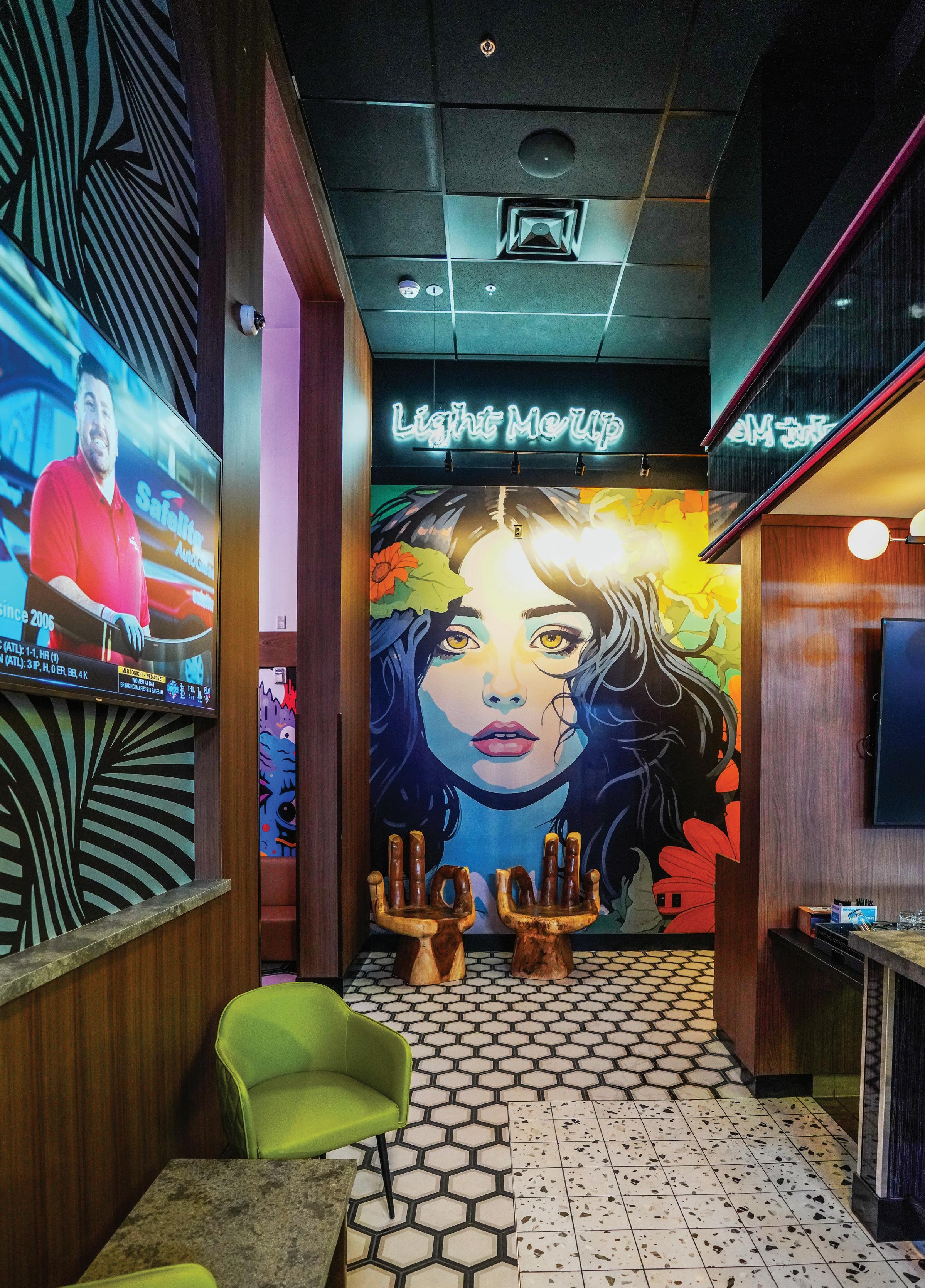
beautiful, artistic graphics. There are murals of ladies who look like space creatures. One is smoking a joint, and another has cool flowers behind her. The artwork creates this really positive environment and a completely spectacular out-ofthis-world experience.”
In other words, Dazed is unabashedly Instagrammable. That should come as no surprise. Planet 13’s Vegas location was one of the first dispensaries to embrace viral socialmedia marketing.
“I think people love taking photos inside the lounge to share with their friends,” Brown said. “It’s just one of those things. If you don’t have a picture of it, it didn’t happen in Vegas, right? Not only are guests excited about the products and what they’re doing, but they love sharing the space they’re in.
“We also have cannabis-infused cocktails in vibrant orange colors that go with the aesthetic,” he added. “Customers are overwhelmed in the best possible way.”
Dazed is the answer to an increasingly common question among Vegas tourists: “I just bought some weed at a dispensary … but where can I consume?” City ordinances explicitly prohibit consumption in public, hotel rooms, and short-term rentals. Licensed for public consumption, Dazed is one of a few safe spaces for tourists and others to partake responsibly and legally.
“For our more avid consumers, we also have some really nice, high-end equipment that’s quite the draw, like our electronic Puffco dab rigs or our Zenco devices,” Brown said. “This is a really fun experience for people who want to try a different consumption method. It’s another Instagrammable moment and an innovative way of consuming. You’re not just rolling up and smoking out of a bong—although we have those too.”
What happens in Vegas…
The lounge isn’t just about aesthetics. It’s also a hub for community and entertainment. Weekly Ha Ha Comedy Nights feature local comedians and tie in with the in-house Ha Ha brand of infused sodas and gummies. Sports fans can enjoy watch parties for Las Vegas Raiders football games, Golden Knights hockey, or Ultimate Fighting Championship matches, which more often than not are accompanied by meet-and-greets with athletes.
“We want to make every experience special,” Brown said. “This is part of our initiative with the Planet 13 lifestyle brand, which focuses on apparel. So on fight nights, for example, we sell different types of fight club gear: gloves, shin guards, wraps, etc. UFC fighters come in and sign the gloves, so visitors have mementos to take home to their loved ones after their visit.”
Interactive elements, like a gaming wall styled after retro arcade games, add to the experience. Guests may play popular titles like Mario Kart and Super Smash Bros. on Nintendo Switch consoles, while pinball machines, board games, and tabletop games offer more nostalgic fun. For a fee, groups may rent VIP rooms boasting multiple TVs and gaming stations.
“There’s also a pinball machine in the back of the consumption lounge that is free to play,” Brown said. “People come in and challenge their friends, try to beat each other’s high scores. It’s a fun environment designed to amp up the interactivity.”
For special holidays like Halloween and New Year’s Eve, the lounge transforms itself with DJs and themed décor, inviting guests to party hearty as they consume.
“In general, we always want to match the tone of what’s happening in greater Vegas,” Brown said. “For example, in December we have a rodeo coming
to town, so we might switch up the music. If we see a crowd coming in with cowboy hats, we’re throwing on some country music to complement their vibe.”
That being said, Dazed always aims to find a comfortable balance between Vegas hype and cannabis chill.
“I think the environment can really affect people’s high, and Vegas can be overstimulating,” Brown said. “So on normal days, we’ll play some 311 or reggae. We have a mix we shuffle through to make sure people aren’t experiencing anything negative or overwhelming.
“We want to keep people happy—and it always goes back to the concept of a speakeasy,” he continued. “You’re in your own private space that feels like you’re at a friend’s house. There’s no judgment, no competition, no one trying to outsmoke one another. You can go low, slow, and stick to your own, comfortable pace.
“We’re really proud of what we’ve built here,” he added. “Dazed Lounge is not just a place to consume cannabis; it’s a celebration of creativity, community, and the evolving culture. Whether you’re a first-time visitor or a lifelong enthusiast, there’s something here for everyone.”


Retail media networks offer brands and stores exciting new ways to connect with consumers, generate trackable sales, and collect data.
The American retail sector is experiencing a structural shift and redefining how consumer packaged goods brands and retailers approach advertising and marketing. Advanced technologies like artificial intelligence (AI) and the internet of things are fueling the rise of “smart stores,” bridging the gap between online and in-store shopping. From AI-powered shopping assistants and scan-to-shop technology to holographic displays, kiosks, and connected TV (CTV), companies are building retail media networks that create new, trackable advertising opportunities. These innovations provide brands access to more of a retailer’s rich first-party data, enabling precise audience targeting and real-time measurement of ad performance throughout the customer journey.
For dispensaries, this shift represents a way to enhance the shopping experience and offers a lucrative new revenue stream by providing brands an omnichannel advertising platform for connecting with consumers.
Dispensaries may benefit from the rise of retail media networks more than traditional stores. With mainstream advertising channels like Google, Meta, and linear TV still out of reach due to federal restrictions, cannabis brands face significant hurdles in traditional marketing. Moreover, stateby-state legalization limits companies to operating only within their local markets, diminishing the need for costly national campaigns. This makes retail media networks an ideal solution by providing hyper-localized advertising options that capably address the industry’s regulatory and geographic challenges.
Cutting-edge tools retailers can leverage to enhance the shopping experience while collecting and utilizing valuable first-party data are just beginning to appear. AI-driven capabilities allow for dynamic, personalized promotions that engage consumers as they shop, fostering stronger connections between shoppers and ads. Brands now can integrate their advertising across retailers’ ecosystems—through e-commerce platforms, mobile apps, and physical stores—while benefiting from digital tracking’s transparent, real-time performance metrics.
BY PAM CHMIEL
Businesses commonly use AI in the form of customer service chatbots or to provide personalized recommendations and improve e-commerce searches, but AI is making its way into the retail setting. Google Shopping made the move with Google Lens, an app that lets you snap a picture of a product and instantly discover where to buy it, compare prices, and check inventory—all in real time.
AI-assisted shopping is particularly useful in the cannabis industry because of the newness of consuming the plant in an edible, beverage, or vape format and the unfortunate relative scarcity of relevant science. Most people grapple with understanding cannabinoids and their benefits, the differences between manufacturing processes, and the dizzying number of strains in the marketplace.
While journaling and product-matching apps have struggled to gain traction as standalone platforms, some developers are finding success now by integrating their software within dispensary ecosystems. This new strategy allows apps to leverage dispensary infrastructure and create a more robust shopper experience.
One standout example is Jointly, an app that has been refining its platform since 2018 by partnering with dispensaries. Jointly enables users to track their cannabis consumption, providing rich data insights into what products and combinations work best for various goals. “We gather consumer insights on what’s effective for users and share that knowledge with others to help guide their product selection,” said Chief Executive Officer David Kooi. By harnessing the data, Jointly offers dispensaries a suite of AI-powered tools, including a virtual budtender for websites and kiosks and a budtender sales assistant, benefiting both the consumer experience and dispensary operations. Jointly’s virtual budtender lives on the dispensary’s website and acts like an online concierge, helping guide people through the menu or answer questions


The more personalized we can make shopping, the better experience consumers will have.”
—David Kooi, CEO, Jointly
like “What are your hours? What’s the difference between CBN and CBG? Do you have a parking lot?”
Accessible through both websites and in-store kiosks, the virtual budtender can help increase basket sizes by nearly 25 percent, according to Kooi.
Meanwhile, Jointly’s budtender sales assistant supports in-store staff by integrating with point-ofsale systems. The software offers real-time access to product inventory and sales data, helping budtenders provide more precise recommendations. “There are hundreds of SKUs in a store, and it’s unrealistic for staff to be familiar with all of them,” Kooi explained. “It’s a tool to help budtenders match people more precisely with products in their store. Some people just use it as a training tool; a place to ask questions and get answers. Others are starting to use the words ‘professional development’ around it, which I’m pretty excited about.”
Jointly employs machine learning technology, meaning the more the app is used, the more knowledgeable it becomes. “The goal is to collect as much useful data as possible and put it to use for consumers,” said Kooi, who sees a larger convergence of personalization happening in the cannabis industry through marketing and e-commerce tools. “Cannabis is a personal experience, but the shopping experience





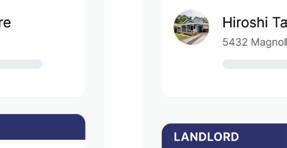











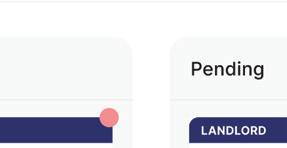

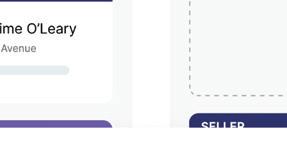




can be a little impersonal right now. The more personalized we can make it for folks, the better experience they will have.”
A twist on the Jointly app is HashDash, which focuses on matching consumers with strains. Unlike Jointly, which emphasizes product recommendations across a broad range of criteria, HashDash zeroes in on characteristics, using a sophisticated algorithm to direct users to nearby dispensaries carrying specific strains or products with similar cannabinoid and terpene profiles. HashDash also partners with dispensaries and integrates into their point-of-sale systems to provide the same product pairing capabilities.
With a database of more than 5,200 strains and 630,000 data points, HashDash leverages AI and machine learning to refine its matching capabilities based on user interactions. The app also allows users to share their experiences with different strains. For instance, Suzy from New York might report success in alleviating migraines with myrcene-rich OG Kush, guiding others with similar symptoms toward potentially effective options.
Scott Lynch, CEO of HashDash, explained, “Our goal is to help consumers understand cannabis at its most fundamental level: strains, terpenes, and cannabinoids. These are the building blocks for understanding




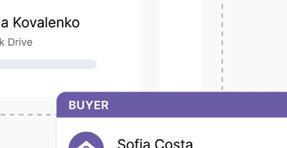

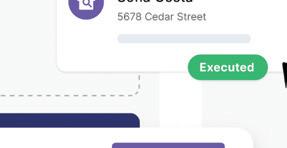



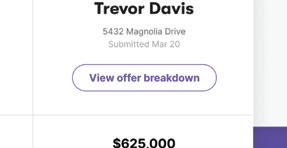

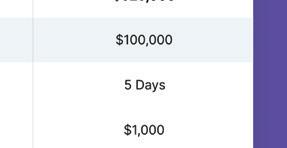








Jointly provides insight based on consumers’ self-reported experiences.
cannabis’s effects, far beyond the outdated sativaversus-indica categorization.” By educating users about these complexities, HashDash aims to deepen consumers’ knowledge and help them make more informed choices.
In addition to its consumer-facing features, HashDash offers brands a valuable advertising platform. Unlike broader platforms like Weedmaps or Leafly, which sell ad impressions based on cost per thousand, HashDash uses its in-depth consumer preference data to deliver hyper-targeted ads. “The [return on investment] for brands is significantly higher, because we tailor ads to individual consumers’ specific needs and behaviors,” said Lynch. “This level of precision allows brands to connect more effectively with their target audience, driving better engagement and sales.”
Holographic displays are making waves in traditional retail as a cutting-edge way to captivate consumers and revolutionize in-store advertising. By offering a visually impressive experience, brands are betting the futuristic displays will be impossible for shoppers to walk by and ignore.
Shawn Landgraf, CEO of holographic display company Holovisn, is piloting the technology in cannabis with a major multistate operator. The program tests whether holographic advertising can drive sales and uses performance data to attract brands to adopt the technology. “Our goal is to prove that holographic displays are more than just eye-catching,” he said. “They can be a powerful sales tool.”
According to Landgraf, the biggest part of his business in traditional sectors is creating “holographic humans” who can interact with consumers. “Using AI capabilities and holographic technology, we put Barbie into a box for our client Disney,” he said. “We wanted people to be able to walk up, have a conversation, see her dance and even drink a [beverage from] Starbucks. These are some of the future capabilities of holographic technology.” Holovisn also created a real-life version of Usher for the performer’s recent world tour so fans could engage with him. Snoop Dogg, are you listening?
One common concern with adopting holographic displays is the perceived high cost. However, Landgraf emphasized Holovisn offers flexible pricing models. “We provide two options: Brands can purchase the holographic equipment outright, or we can deploy the technology at no cost to the dispensary. In the latter case, we collaborate with the dispensary to onboard advertisers, sharing revenue based on the brand’s initial investment,” he said. This flexibility lowers the barrier to entry, making it easier for dispensaries and brands to experiment with holographic advertising. By turning retail spaces into interactive, high-tech environments, holographic displays could offer a significant edge in captivating customers.
Holographic technology has the potential to transform cannabis retail by delivering a unique and memorable shopping experience. As more dispensaries explore the medium, they’ll differentiate themselves and unlock new revenue streams through brand partnerships. If early pilots like Holovisn’s prove successful, we may soon see holographic displays as


Holographic displays ... can be a powerful sales tool.”
—Shawn Landgraf, CEO, Holovisn
a standard feature in dispensaries, changing the way products are marketed and sold.
The cannabis industry is taking cues from mainstream retail innovations, with scan-and-shop technology leading the charge. Instacart recently debuted a scan-and-pay app that lets grocery shoppers skip the checkout line. BLAZE is pioneering similar technology for cannabis. Scott Roehrick, vice president of e-commerce, explained the company’s system enables customers to walk through a dispensary, scan products to learn more, add items to their cart, and complete the checkout process entirely on their phones.
Roehrick admits the technology, which BLAZE calls Scan to Shop, is slightly ahead of its time for dispensaries since most products are locked within glass display cases or digitally displayed. Early adopters like Airfield Supply Co. in San Jose, California, are leveraging it nonetheless. Airfield CEO Mark Matulich said, “Scan to Shop works well. I wish we had more customers adopting it.” With its openshelf layout, Airfield allows customers to browse, scan QR codes for detailed product information, and shop at their own pace.
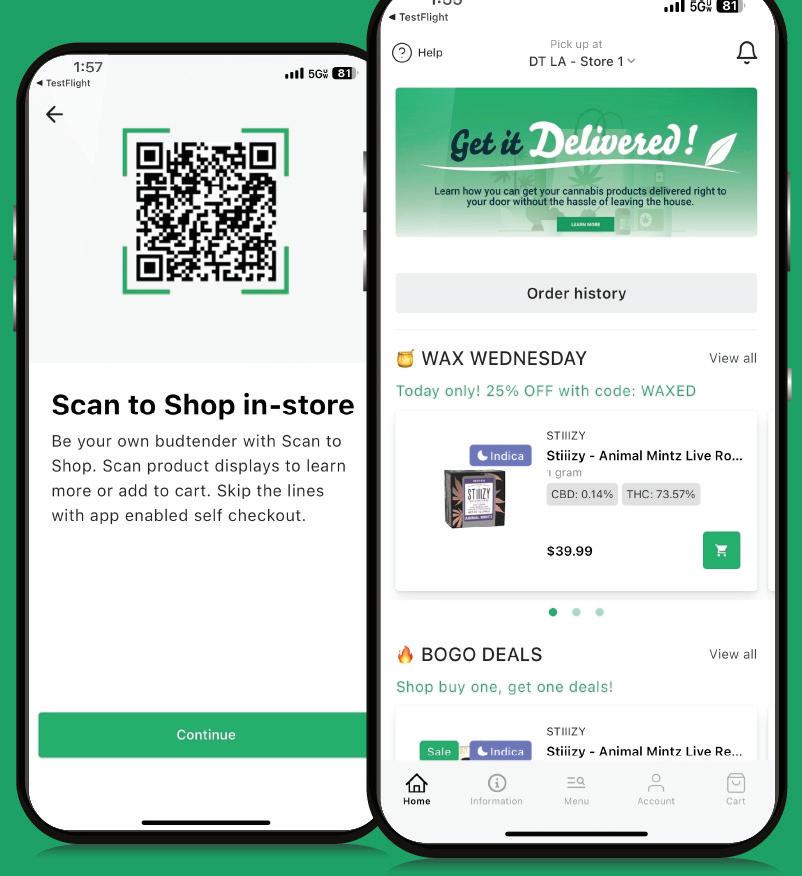
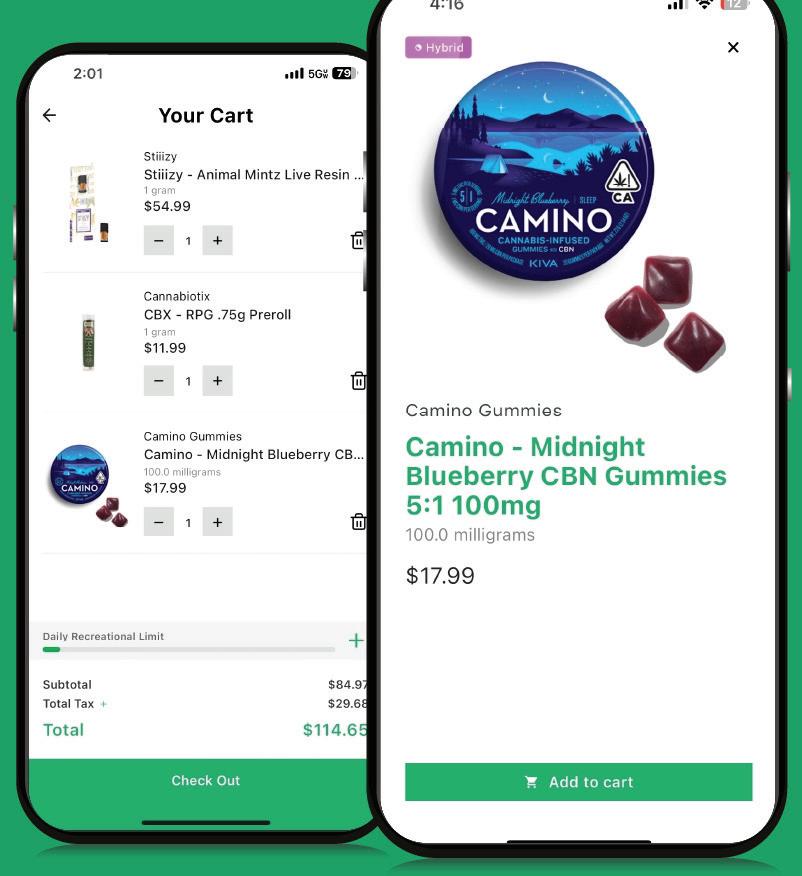
Scan to Shop is making waves at large industry events, according to Roehrick. BLAZE implemented the system at major expos like The Emerald Cup, Hall of Flowers, and Flower Expo, streamlining the often cumbersome purchasing process at vendor booths. Previously, attendees would receive tickets to redeem products at a separate pickup location, leading to long lines and the risk of sold-out items. With Scan to Shop, attendees can scan a product’s QR code, add it to their virtual cart at any point during the event, and check out when they’re ready without worrying the products won’t be available.
The technology is poised to be a game-changer as more public events, such as concerts and state fairs, begin to allow on-site cannabis sales. Event producers can use Scan to Shop to track inventory and streamline transactions across multiple vendors, creating a more efficient and satisfying customer experience.
BLAZE also is building dispensary-branded mobile apps (think Starbucks) to capture sales and incentivize loyal customers who want exclusive deals. For instance, dispensaries can offer app-exclusive deals— such as a special promotion every Friday—while using push notifications to engage directly with their audience. It’s all about meeting customers where they are and keeping them in your ecosystem. Roehrick
pointed out, “Choosing the right combination of in-store technology depends on your retail footprint and business goals. It’s about understanding how you want customers to move through the value chain and incentivizing them effectively.”
As cannabis retail continues to evolve, technologies like Scan to Shop and branded mobile apps will play an increasingly crucial role. By making shopping more seamless and personalized, these tools not only enhance the customer experience but also boost dispensaries’ sales and efficiency. Once mainstream retail fully adopts scan-and-go shopping, consumers will come to expect it in dispensaries.
Offsite kiosk opportunities are emerging for retailers and brands, enabling product delivery through noncannabis businesses in a compliant and convenient manner. Branded kiosks offer dispensaries expanded name recognition and the chance to tap into new revenue streams through product sales and targeted brand advertisements.
One of the most exciting applications of the technology is within the growing field of cannabis tourism. As more travelers seek plant-friendly accommodations, hotels and vacation rentals will start
to cater to this demographic. Platforms like Bud and Breakfast and HiBnB already list marijuana-friendly properties worldwide. By installing kiosks that allow orders on site with delivery or pick-up at a nearby dispensary, such establishments can provide guests with an easy way to explore and purchase products. Properties maintaining a smoke-free ambiance can curate kiosk menus featuring smoke-free products such as topicals, edibles, and beverages. This would allow them to accommodate plant-aware consumers without compromising the comfort of non-smoking guests.
Beyond hotels, attractions like the cultural museum THC NYC are leveraging kiosks to elevate the theme and visitor experience. The delivery kiosk allows patrons to place an order, enjoy the exhibits, and receive a notification when their items are ready for pick-up. A kiosk also can be found in the museum’s fifth-floor lounge and event space, offering guests the convenience of on-site delivery during private events or after a long day of exploring the exhibits.
A ShareThrough survey found 60 percent of respondents had purchased products on their phone, computer, or tablet after seeing an ad on TV, and 58 percent said they would use their remote to buy a product or access a coupon if offered.
With its interactive features, CTV advertising increases viewer engagement through QR code shopping features. Cannabis-focused channels like Citizen Green TV are capitalizing on this trend, offering real-time interactivity through QR codes that link viewers to exclusive deals, certificates of analysis for lab-tested products, or brand storytelling pages. Plus, with CTV’s video-on-demand capability, viewers can pause to explore brands they’re interested in, making the technology a powerful brand-building tool.
Citizen Green TV even allows shopping, where viewers can hover over products with their remote to add items to a shopping cart for immediate purchase, which they can pick up at the nearest dispensary. Brands also can leverage on-demand printing to sell


You don’t need a Super-Bowlquality ad for CTV. Even basic ads work well.”
—Jake Litke, CEO, MediaJel
branded merchandise, adding extra value to their CTV ads. Marketers view QR codes as a “golden ticket” for tracking conversions and measuring success, giving brands a direct path from exposure to action.
Cryptocurrency app Coinbase is a perfect example of how effective QR codes can be. Coinbase featured a QR code with a call to action and a special offer in a one-minute spot during Super Bowl LVI. According to news reports, so many football fans scanned the code that the company’s website crashed as a result of the increased traffic.
Walmart launched its first shoppable CTV ads featuring QR codes during the 2024 Thanksgiving night NFL game, pointing to the growing bridge between digital and retail advertising. NBCUniversal increased its number of advertisers by 40 percent by expanding its programmatic buying and offering performance-based campaigns.
Actor Ryan Reynolds is betting on CTV advertising as the next frontier for marketers. His company, Maximum Effort Marketing, recently was acquired by MNTN, a CTV advertising technology firm. Reynolds serves as chief creative officer and is developing commercial content targeting small businesses that typically shy away from TV advertising because of the cost. Reynolds claims 90 percent of Maximum Effort Marketing’s clients are first-time TV advertisers.

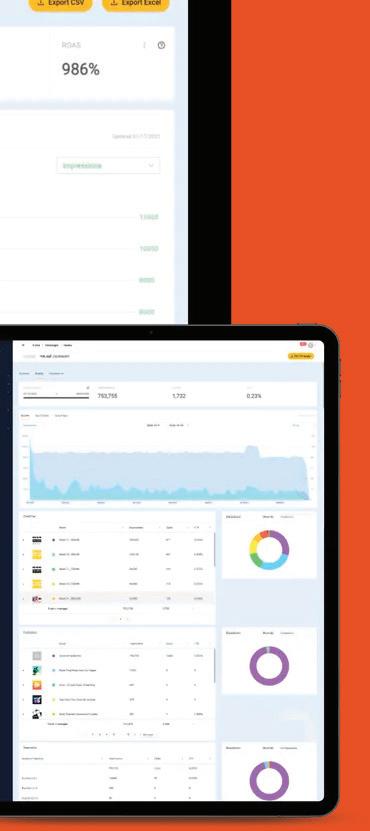
MediaJel’s platform gives marketers access to CTV advertising data.
Historically, TV advertisers had to rely on trust that their ads would reach the intended audience, with limited options for tracking effectiveness. Jake Litke, CEO of MediaJel, an adtech platform specializing in the cannabis industry, has developed an attribution platform that gives marketers access to valuable CTV advertising data. “The main pillar of our functionality is the ability for advertisers to see how their ads influence sales through precise tracking data,” he said.
Litke believes the time is ideal for cannabis brands to embrace CTV advertising. “Not only is it an opportunity we’re ready for, but it’s also an uncrowded space for the cannabis industry right now. Your competition will likely be insurance ads and similar content, not other cannabis brands.”
He encourages advertisers to give CTV a try, noting, “There’s a misconception that you need a Super-Bowlquality ad for CTV, but that’s not necessary. Even basic ads work well on this platform.”
As for budget, Litke advised, “If you’re targeting a specific neighborhood, you don’t need a huge budget. But, typically, you should plan for tens of thousands of dollars to see impactful results.”
North American president of Citizen Green TV, Steve Peterson, agreed CTV is a game-changer. “Integrating ads into streaming video content and delivering them to a targeted, scalable market is the next evolution
in cannabis advertising,” he said. “Streaming TV offers cannabis brands access to a wide demographic, making it an untapped platform for standing out in an increasingly competitive market.”
As the cannabis industry embraces cutting-edge retail technologies, creating a fully connected retail media network is the next frontier. Investing in robust attribution platforms will be crucial for dispensaries to maximize the potential of these innovations. The systems can provide granular insights into the customer journey, from initial engagement with a holographic display or virtual budtender to the final purchase, whether in-store or through scan-to-shop technology.
AI-driven analytics will allow accuracy in measuring return on ad spending, moving beyond vague “sales bumps” to pinpoint which campaigns, touchpoints, or technologies truly drive revenue. In a market where compliance limits traditional advertising, building and optimizing these omnichannel ecosystems is the boost retail businesses need.
The cannabis retail revolution is underway, and those who seize the moment and integrate innovative technology and precise attribution will lead the industry into its next growth phase.
Brands aim for cooler clouds and more markets in 2025.
BY SUE DEHNAM
Vape pen sales in the United States reached $4.3 billion in 2023 and, after all sales are tallied, likely will have eclipsed $5 billion in 2024. While flower continues to outsell every other category by a wide margin, the vaporizer segment consistently stands out as the second largest category in terms of sales. According to market analysts at Headset, vape pen sales represent about 19–27 percent of total sales in legal markets across the country.
In California, Stiiizy’s $20-per-gram pods dominate the market with nine of the ten top-selling products. In Colorado, Spherex’s $15-per-gram pods likewise hold all but one of the top ten spots. In Illinois, multiple brands
including Good News, Redbud Roots, &Shine, Simply Herb AiroPro, and Savvy are jockeying for the top of the state’s top-ten list, while in New York, consumers spend more than $60 per gram for the Empire State’s two topselling disposables by Ayrloom.
Vape brand preferences and prices vary widely across the country, demonstrating the importance of price in established markets out west and the likelihood of a single brand positioning itself to reap serious rewards.
The following hardware—brand new or redesigned for 2025—offers brands and retailers in all but the most mature markets an immediate opportunity to compete for dominance before price compression and brand loyalty become nearly impossible to overcome.

Launched in late 2024, DaVinci’s iQ3 is a handheld vape for flower and concentrates. Crafted of aircraft-grade brushed aluminum and zirconiaglass components, the device offers a high-quality look and feel backed by a ten-year warranty. The iQ3 cools vapor by 50 percent compared with previous models, allowing for up to ninety minutes of use on a single charge. Temperature control is precise, with one-degree intervals up to 430°F.



Battery
MSRP: $59


Launched in January, OPTO is a first-of-its-kind vaporizer with three customizable modes that help users design their own experience: flavor mode (for terpene-rich strains), zone mode (for balancing flavor and vapor density), and vapor mode (for dense vapor at the optimal temperature).
Engineered for use with all 510-thread oil cartridges, OPTO’s innovative OLED display features a “puffs remaining” counter to track battery life and a draw counter to track usage and monitor cartridges. The convenient charging stand includes a heat sensor to prevent the cart from heating up while the device is docked.







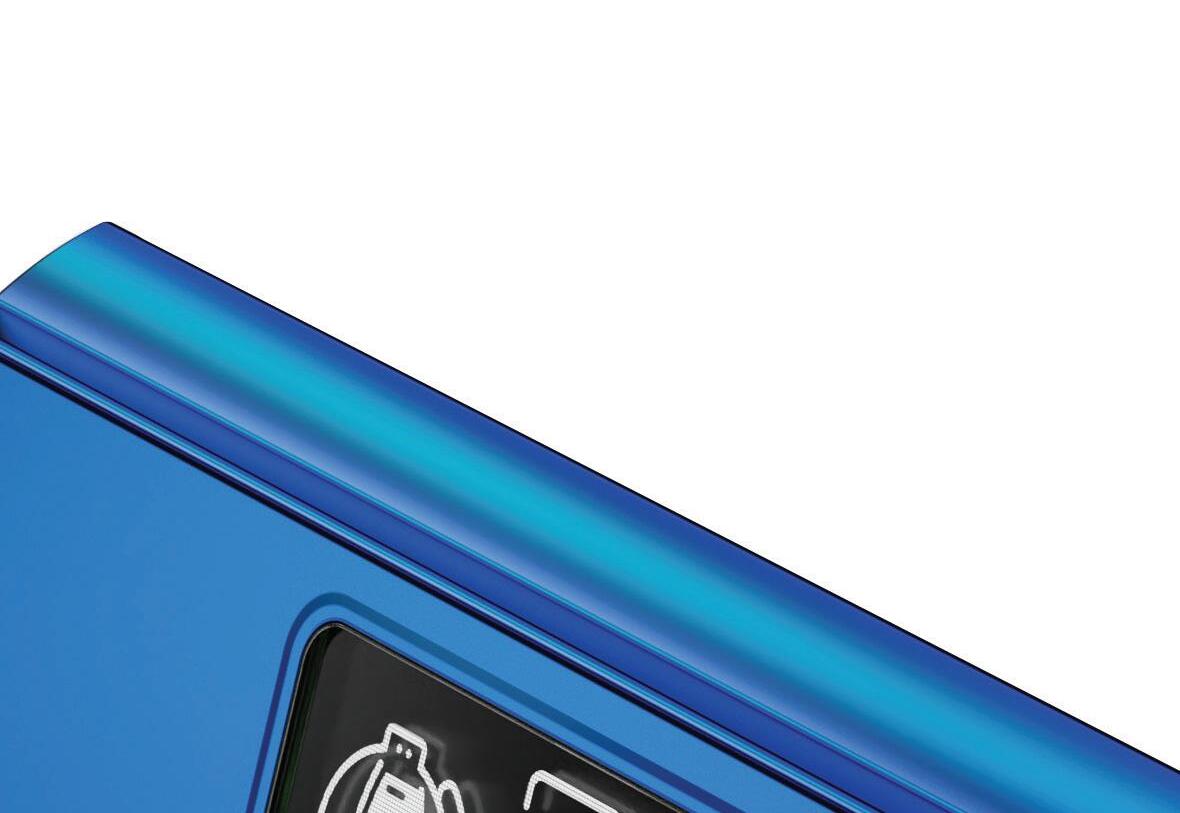

















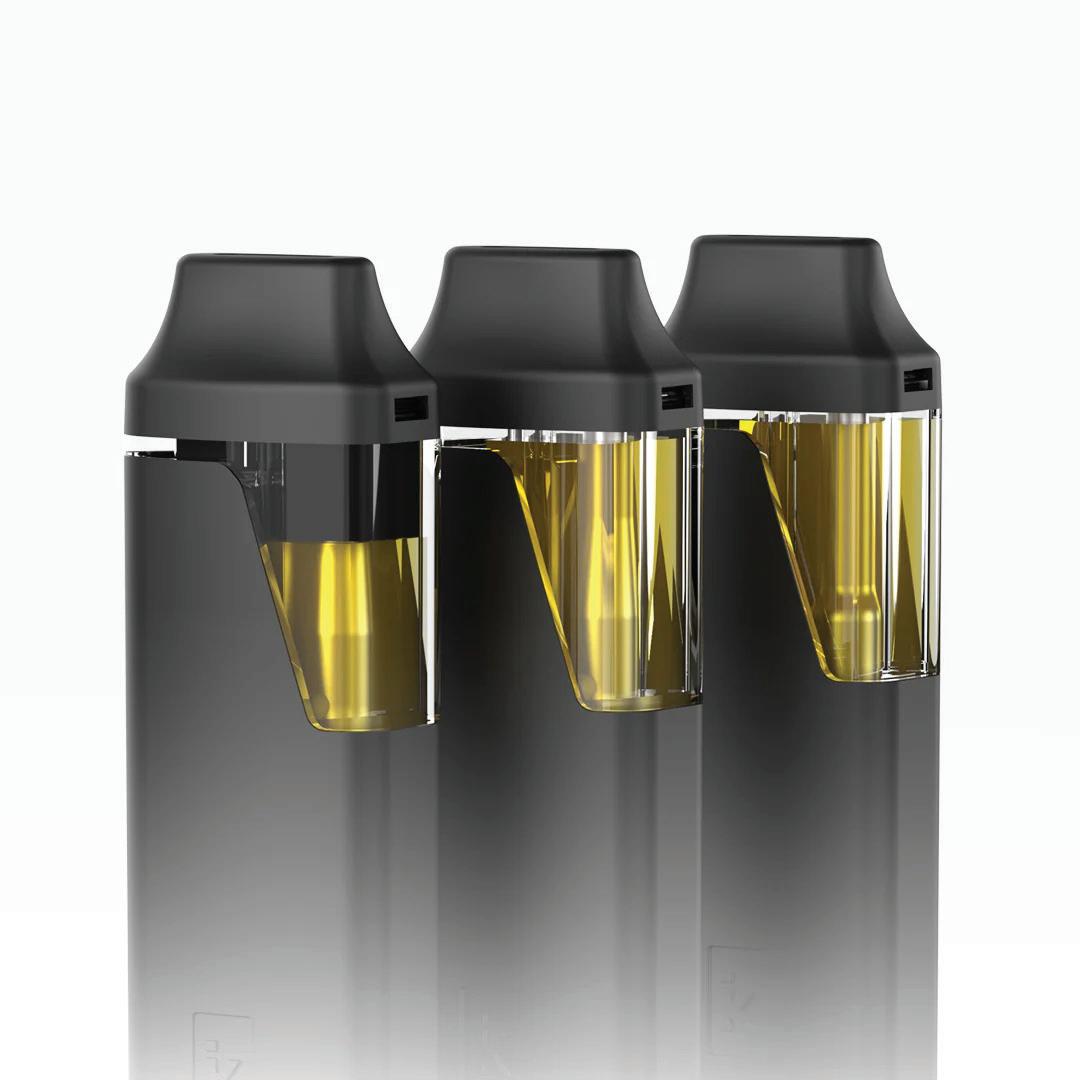








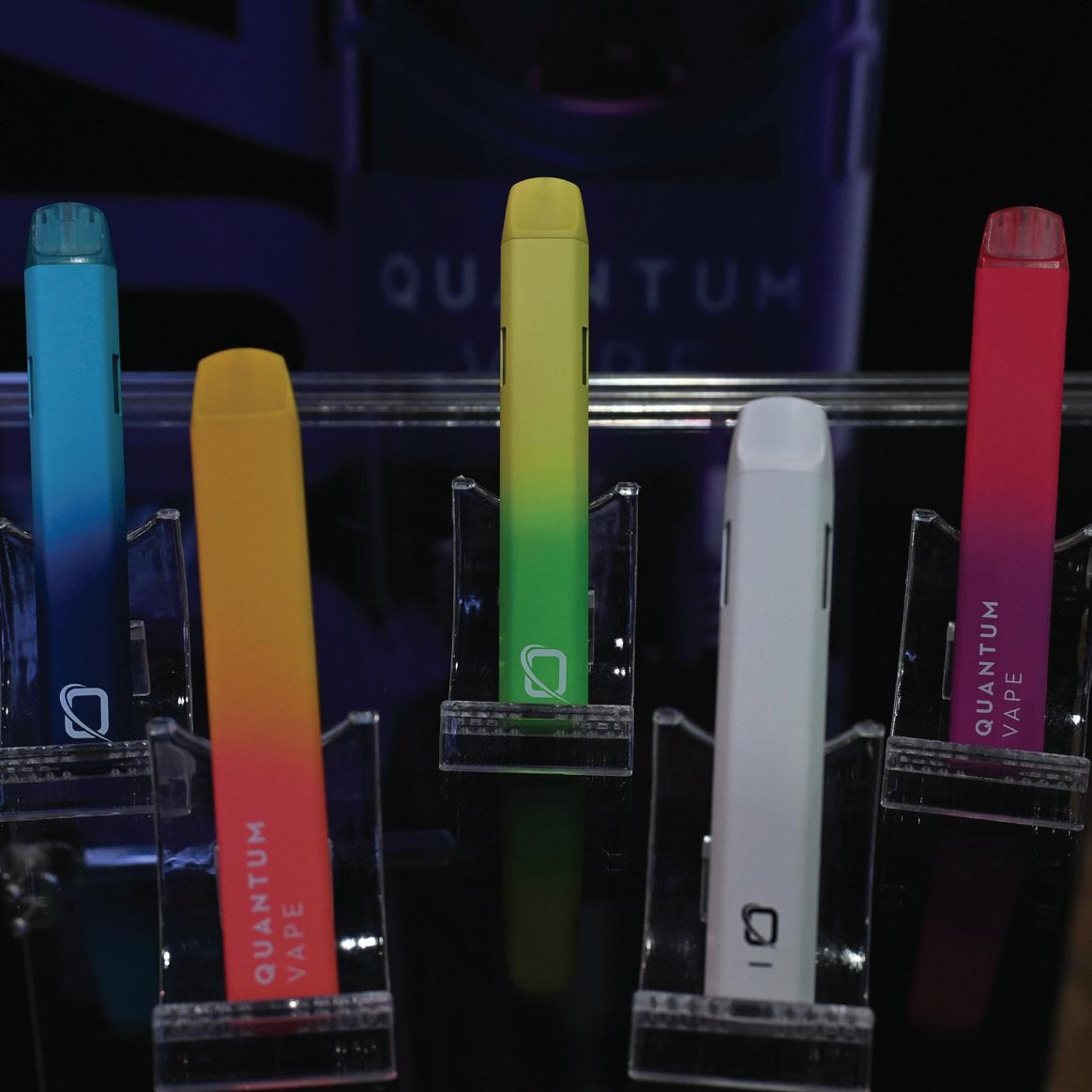
All-in-one
Wholesale: $3.50 per unit
Leaning into the discretion aspect of the category, the Uzo series of micro-sized all-in-one vapes are smaller than the average lighter with immediate inhale activation. Available in half-gram, full-gram, and two-gram options, each device features a 260mAh lithium-ion battery and ample brand customization options including oil window shape, atomizer resistance, aperture modification, custom logo, LED color, and shell color. The Uzo is compatible with OMNI Connect, iKrusher’s smartphone app control system with dual-channel near field communication that lets businesses fine-tune their products and provides consumers with more control.
Battery and cartridges
Wholesale pricing varies
After three years in development, Greentank launched its all-new Quantum Vape just in time to greet 2025. The chip powering the heating element is designed to preserve flavor consistency from the first pull of a new cartridge until the oil is depleted. According to the manufacturer, the biocompatible heating element instantly vaporizes oil and delivers it 52-percent cooler than other 510 cartridges on the market. The tanks have a premium look and feel that’s especially noticeable in the precision of the threading and the mouthpiece’s contours.












PAX Era Go Battery
MSRP: $20
The redesigned PAX Era Go vape pen incorporates an anti-clog feature that automatically prevents all 0.5g and 1g Era pods from clogging. According to the manufacturer, the redesign allows the pen to provide up to 50 percent more vapor. The device’s patented technology offers a single, oilfriendly temperature for a consistent experience without burnt flavor. Available in gold, sky, lavender, and black, the device can last up to 180 days on a full charge.











All-in-one for concentrates
Wholesale: $5.78 per unit
DabGo is a disposable dab pen with a half-gram capacity, flat mesh ceramic bowl, and lead-free glass mouthpiece. Proprietary SegmHeat ceramic technology preheats and vaporizes solid concentrates in stages for progressive heat control and distribution. The 230mAh battery provides up to 7.8 watts of power, enough to vaporize live rosin, live resin, shatter, wax, and budder. Filling the device is easy through automation or manual labor with a simple snap-on window lid that bears a convex lens designed to magnify the concentrate and amplify the user experience.







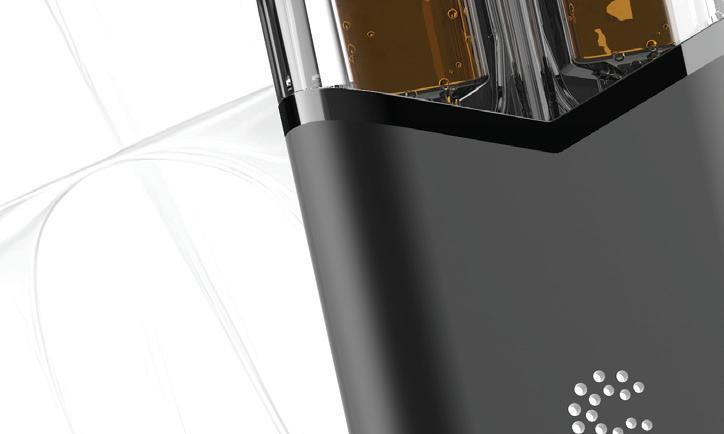

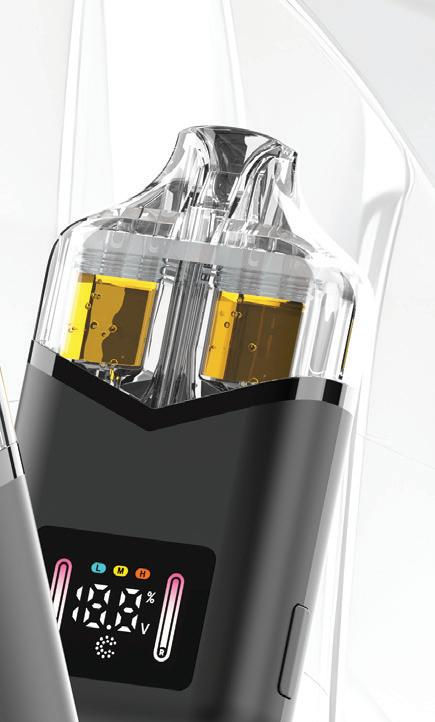

All-in-one
Pricing unavailable
The CCELL 3.0 MixJoy, which will debut in April, is an all-in-one vape with two oil reservoirs, allowing for two strains or unique mixtures of cannabinoids and terpenes in one disposable product. The device features a cottonless “ultra-low-temperature” heating core developed over six years and designed exclusively for cannabis oil. According to the manufacturer, the new heating technology provides a “true-to-plant” flavor without any hint of burning or leaking. With two tanks, brands can deliver unique and in-demand combinations of terpene-rich CBD and THC, freeing their customers from decision paralysis.





All-in-one
Pricing unavailable
Expected to launch near the end of the first quarter, CCELL’s GemBar also features a cottonless heating core designed to deliver bigger, cooler vapor clouds without burning. According to the manufacturer, the company’s new bio-heating solution warms extracts at a temperature 30-percent lower than any other mainstream product on the market. Named for its prism-cut, gem-like oil tank, the GemBar’s large viewing window allows users to monitor the oil level with ease.
As prohibition relaxes, scientists finally are able to give the plant the attention it deserves.
BY DAVID SANDELMAN
For years, federal prohibition has stifled the cannabis industry, restricting the scientific research needed to deepen our understanding of an incredibly complex plant. But times are changing. Recent breakthroughs in research finally provide a clearer picture, particularly when it comes to the critical role post-harvest processing plays in preserving the plant’s quality and potency.
Federal prohibition has created unique challenges for research in our industry compared to other agricultural fields and medicinal plants. Limited funding, lack of institutional support, and persistent stigma also have hindered progress in fully understanding the complexities of cultivation and processing. As a result, much of the industry has relied on passed-down methods and anecdotal evidence, rather than scientific data, to guide cultivation practices.
In recent years, researchers at the Cannabis Research Coalition (CRC), the Colorado-based Institute of Cannabis Research, and those using California tax revenue for academic study, among others, have taken it upon themselves to advance scientific knowledge despite the roadblocks inherent in researching federally controlled substances.
We’ve learned a lot, but it’s important to consider how the industry can benefit immensely from supporting academic research. While I’m particularly
fascinated by trichomes, others are interested in edibles’ onset time, CBD topical formulations’ efficacy, and numerous other fields of study. But let’s talk about trichomes and what recently has been discovered about these cannabinoid- and terpene-producing powerhouses.
In 2024, CRC announced findings from studies of terpene retention and trichome integrity—two critical factors for cannabis quality. CRC’s results are prime examples of how cutting-edge scientific research is illuminating new best practices that may improve cultivation and production.
In the anatomy of a cannabis plant, trichome glands on the surface of flower and leaf tissues are rather vulnerable. When trichomes are damaged or ruptured after harvest, they release their contents and lose terpenes. This directly correlates with the overall quality of the plant material.
CRC’s terpene retention study, headed by Allison Justice, PhD, compared environmentally controlled post-harvest methodologies to traditional drying and storage techniques. The results were notable. In a tightly controlled environment with stable vapor pressure, dewpoint, and temperature, trichomes experience significantly less damage than when dried with traditional HVAC methods. Under traditional practices, fluctuating environmental factors are common, leading to greater trichome damage.
Conversely, in the environment Justice studied, undamaged trichomes led to higher terpene retention, directly contributing to higher-quality finished flower.
Justice, who earned a doctorate in plant and environmental science from Clemson University, also examined the physical differences between trichomes that experienced fluctuating post-harvest conditions and those maintained in a controlled, consistent environment. Findings revealed maintaining stable vapor pressure levels is crucial for preserving trichome integrity after harvest. The research also pointed to trichome cuticle hardening, which helps retain terpenes, though it remains unclear how this happens at the cellular level. The cuticle, which is part of the trichome structure, influences trichome development, prevents water loss, controls transpiration, and helps transport gases and solutes.
By using tightly controlled environmental spaces after harvest, cultivators can minimize trichome damage and retain more of the plant’s valuable compounds, ultimately enhancing the quality and yield of the final product.
A few other key takeaways about the potential impacts of post-harvest environmental controls and trichome
preservation are worth noting. The studies suggested using a controlled environment during the post-harvest process can produce more consistent results across various cultivars, and better trichome preservation may improve shelf stability and long-term storage potential for products. The research aligned scientific findings with user experiences that suggest better-preserved trichomes contribute to superior smokability, taste, and smell.
It’s exciting to see the industry reach a turning point, with research finally addressing the gaps caused by years of restrictions and limited access. As the industry continues to evolve, educating cultivators about the scientific advancements in post-harvest processing and preservation will be crucial. The potential for consistently producing higher-quality flower through controlled post-harvest processes could benefit both cultivators and consumers in significant ways.
As more research emerges, we can expect a shift toward more precise, science-driven cultivation and processing methods. Technologies like environmentally controlled drying and curing spaces likely will become industry standards, leading to better products and more satisfied consumers.
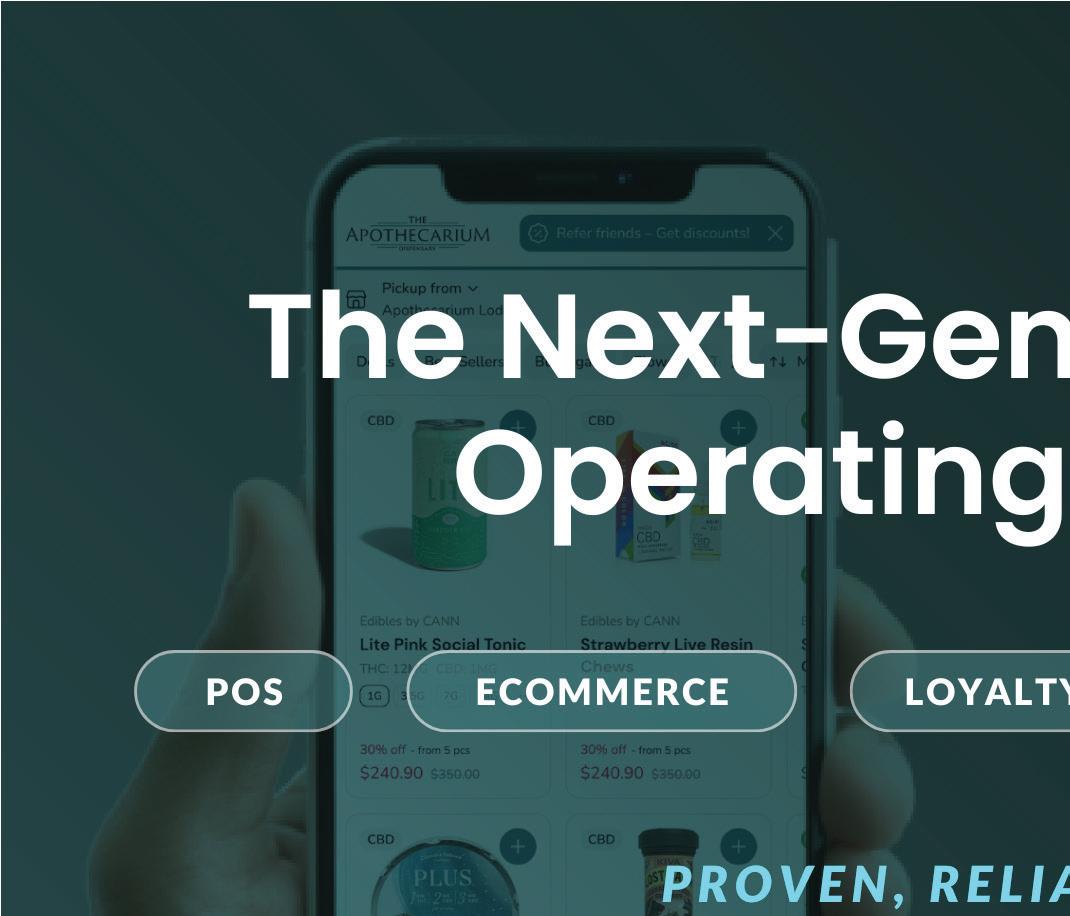




Though much remains uncertain, the financial landscape could see significant changes this year.
BY KEVIN HART
The past few years have been nothing short of transformational for the cannabis industry. But from potential rescheduling to congressional inaction and several states’ inability to pass reform legislation during the 2024 election, there is still much to tackle in 2025.
Let’s take a look at how the banking landscape may shape up in the new year. From regulations and compliance and to state legalization and the growth of financial technology, this year is sure to be dynamic.
In 2025, banking and compliance will be influenced by several uncertainties, including federal rescheduling and recent political developments. The long-awaited Secure and Fair Enforcement Regulation (SAFER)
Banking Act remains in limbo despite more than a decade of congressional consideration.
The likelihood the act will pass this year appears slim. While its passage would benefit the financial services industry, the urgency has waned. Years ago, SAFER could have eased the entry of financial institutions into cannabis banking significantly. Today, more than 1,760 banks and credit unions serve the sector, with many openly embracing the market and meeting regulatory expectations. Automation has reduced compliance costs and competition has grown, making it clear banking is viable even without SAFER.
A greater unknown is the potential impact of rescheduling. The timing and outcome remain unclear,
as the Drug Enforcement Administration, which will make the decision, operates without a fixed timeline. But with complexities involving the Department of Justice and the Department of the Treasury and emerging controversies like the availability of intoxicating hemp products, significant progress in 2025 seems unlikely. Rescheduling may remain a possibility, underscoring the slow and intricate nature of federal policy changes.
Adding to the uncertainty is whether newly inaugurated President Donald J. Trump will make an impact (positive or negative) on federal cannabis policy. He exhibited cautious support during his campaign by extending his blessing to Florida’s failed attempt to legalize adult use, but he previously stated he favors continuing the state-by-state process in place now over federal descheduling.
In 2025, licensed operators will face significant compliance and financial challenges, requiring proactive support from financial institutions (FIs). Access to capital and funding constraints will remain critical hurdles, with FIs needing to enter the lending space to stay competitive by offering new loans and consolidating existing debt.
Additionally, the ongoing wave of mergers and acquisitions will bring heightened scrutiny of financial records and operations. FIs that position themselves as trusted partners will earn client loyalty but also contribute to the success of their partners, creating a mutually beneficial relationship.
Financial technology (fintech) will play a crucial role in addressing the challenges faced by cannabis-related businesses (CRBs) and the FIs that serve them. As cannabis operators expand across multiple states, FIs must offer seamless multi-state banking solutions and consolidation services to support growth and provide a one-stop shop for financial needs. Those unable to adapt risk losing clients to competitors. Regularly re-evaluating and tailoring product offerings—such as depository, lending, treasury, and other commercial banking solutions—and integrating data will be essential to meet the evolving demands of CRBs.
To address compliance and security challenges, fintech solutions must prioritize integrated compliance as a default feature, leveraging the cannabis industry’s
heavily regulated framework to deliver seamless, burden-free solutions. Keeping pace with the security and fraud landscape is equally critical, requiring advanced tools to safeguard individual accounts, detect transaction fraud, and address cash-handling vulnerabilities. Nascent technologies like artificial intelligence and machine learning will be pivotal in enhancing compliance, fraud detection, and operational efficiency while ensuring data quality and privacy remain uncompromised. Without the detailed data feeds that are needed, none of the above will be possible. Outcomes are based on inputs.
Ultimately, fintech must evolve into a full-service, customer-focused financial ecosystem. This includes integrated solutions for payment processing, lending, payroll, and tax-management, all designed to navigate the industry’s unique challenges, including high tax burdens, narrow profit margins, and significant regulatory costs. By fostering flexibility and innovating with data-driven connections, FIs can build lasting partnerships with their cannabis clients and support the industry’s continued growth.
As for banking legislation, state-level initiatives are likely to continue leading the charge this year. States like Delaware have set an important precedent by adopting regulations to support financial institutions in serving the industry, recognizing the security concerns tied to cash-heavy operations. However, such legislation often coincides with major events, such as the legalization of medical or adult-use cannabis, rather than being retroactively addressed in states with established programs.
While some states may follow Delaware’s example, many are hesitant to tackle banking issues independently, relying instead on hope that federal reforms will resolve the challenges. However, the independent approach states historically have taken in defining compliant cannabis programs suggests they won’t wait for Washington to act.
As a result, the patchwork nature of banking legislation is expected to persist, maintaining barriers like the lack of interstate and international commerce, even as revenues and industry growth continue to increase at the state level.
Alternative dispute resolution models help adversaries collaborate on a solution instead of exchanging blows in court.
BY LAURA A. BIANCHI AND JUSTIN M. BRANDT
In the dynamic cannabis industry, disputes are not uncommon, but traditional litigation often proves too lengthy, costly, and adversarial to meet the needs of business owners. Faced with such obstacles, many are turning to alternative dispute resolution (ADR) as a more suitable pathway for resolving disagreements. ADR methods like mediation and arbitration can save time, money, and stress while also preserving relationships essential in the tightly networked cannabis community.
ADR provides a private, collaborative framework, which is especially valuable for businesses aiming to protect sensitive information and reputations. ADR methods are typically informal and solution-focused, fostering mutual understanding and often allowing for a resolution without the need for prolonged legal battles.
Cannabis businesses can leverage two ADR options: mediation and arbitration. In mediation, a neutral mediator facilitates discussions between the parties, helping them work toward a mutually agreeable solution. Control over the outcome stays with the parties, encouraging collaboration and preserving relationships. Arbitration is more structured than mediation but less formal than litigation, employing a neutral arbitrator who makes a binding decision. The process is faster and private, making it particularly appealing to industries where confidentiality is paramount.
The benefits of ADR for businesses include time and cost savings. ADR resolves disputes faster than litigation, which can drag on for years. In a rapidly evolving industry, time is critical, and ADR keeps businesses on track without prolonged disruptions. In addition, ADR keeps disputes private, unlike court proceedings. Confidentiality is essential for companies protecting sensitive information and business processes in a highly scrutinized industry.
Cost efficiency should not be undervalued. Traditional litigation often carries high legal fees, whereas ADR is generally more budget-friendly. With financial demands already high in the sector, the affordability of ADR makes it a smart alternative.
Cannabis-related disputes require more than general mediation or arbitration skills. The industry’s constantly shifting regulations and unique operational challenges mean businesses need ADR professionals with specific expertise.
Effective mediation and arbitration in this industry require an understanding of the unique regulatory and operational challenges the industry faces. A knowledgeable legal firm can help:
Navigate regulatory nuances. Stateby-state regulations vary widely. Advisors who are well-versed in these differences and can manage disputes across jurisdictions will help parties stay compliant and avoid future regulatory issues.
Understand industry challenges.
Cannabis businesses face distinct financial, operational, and reputational pressures. An experienced advisory team can help clients reach resolutions that align with real-world priorities and business goals.
Reach informed decisions. Effective ADR isn’t about reaching just any resolution, but one that works within the industry’s context. A firm that has deep familiarity with cannabis operations ensures decisions are made with a true understanding of the industry’s demands.
Mitigate compliance risk. Each step in the supply chain must adhere to strict regulatory standards. Experts in these nuances can guide clients toward solutions that comply with the law and avoid further regulatory scrutiny.
Address cross-jurisdictional challenges. Regulations differ across state lines, complicating operations and partnerships. A well-versed advisor can help tailor the ADR process to fit each state’s regulatory environment, reducing compliance risks and facilitating smoother operations.
ADR allows businesses to resolve conflicts efficiently, preserving resources and focusing on growth and innovation. Whether mediation or arbitration, ADR is designed to facilitate the right solutions for long-term success.


Journey through the extensive photography archive of mg Magazine with this unique collection of images, each telling a story of resilience and ambition. Moments: Chronicles of Success celebrates the sacrifice, dedication, and perseverance of the individuals who have shaped today’s cannabis industry, offering inspiration for generations to come.
